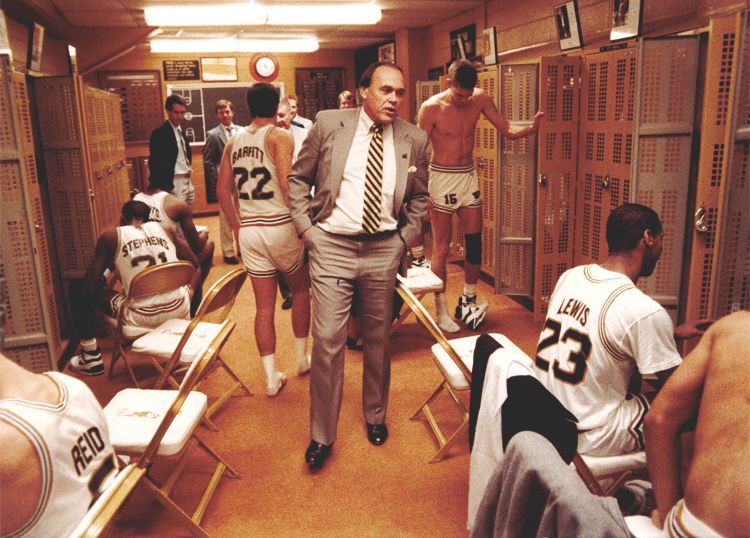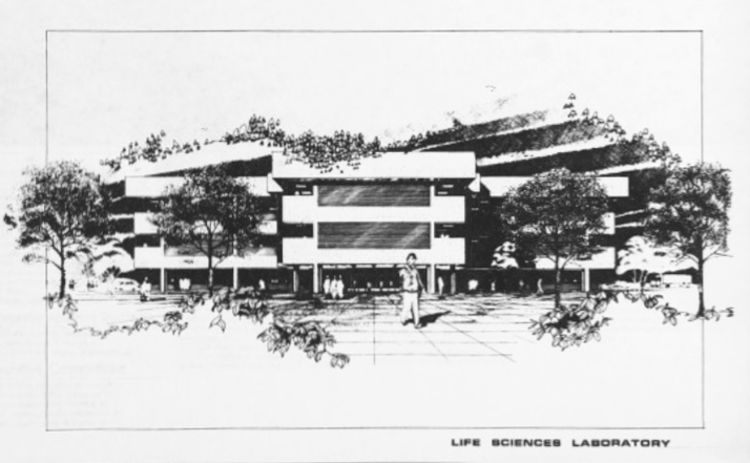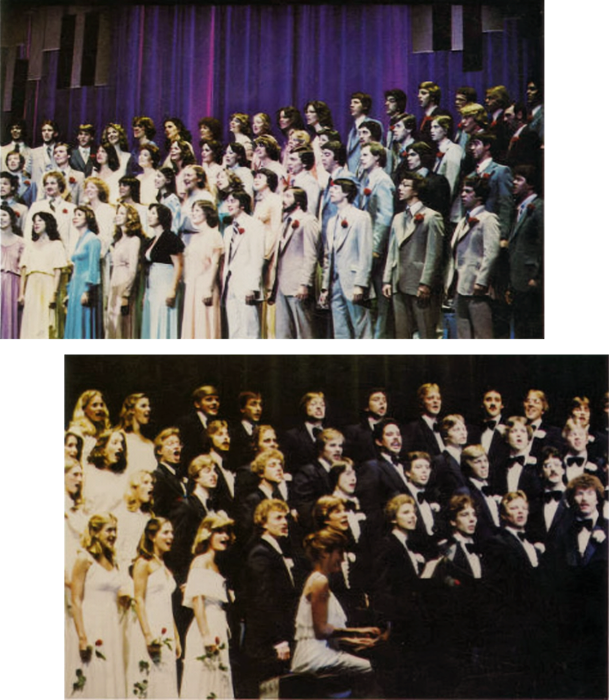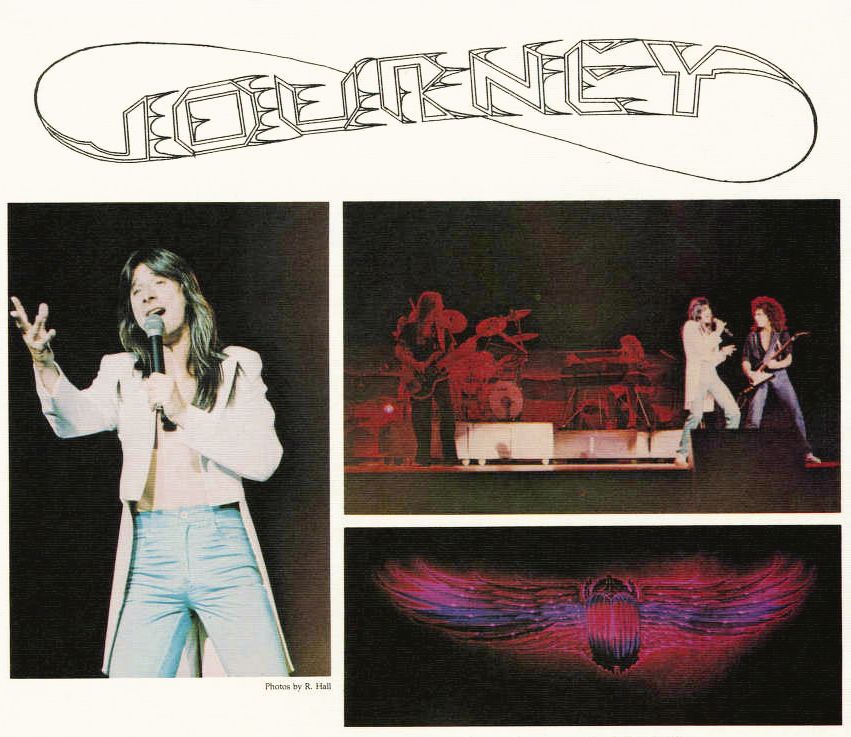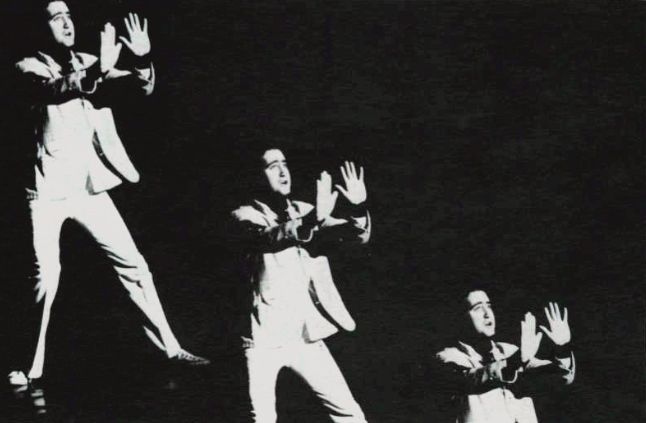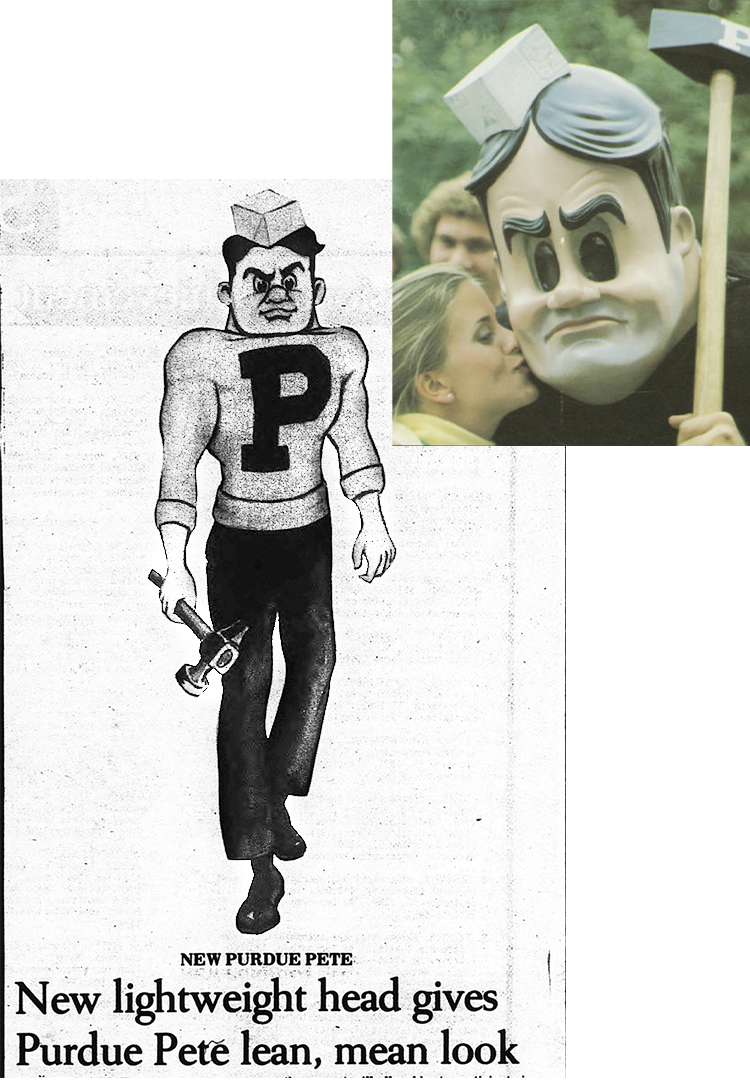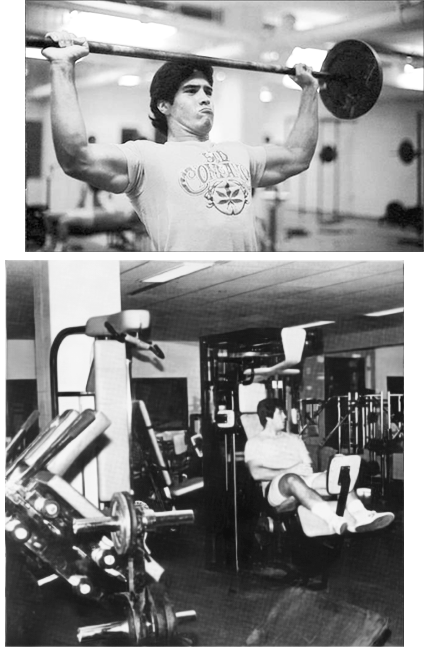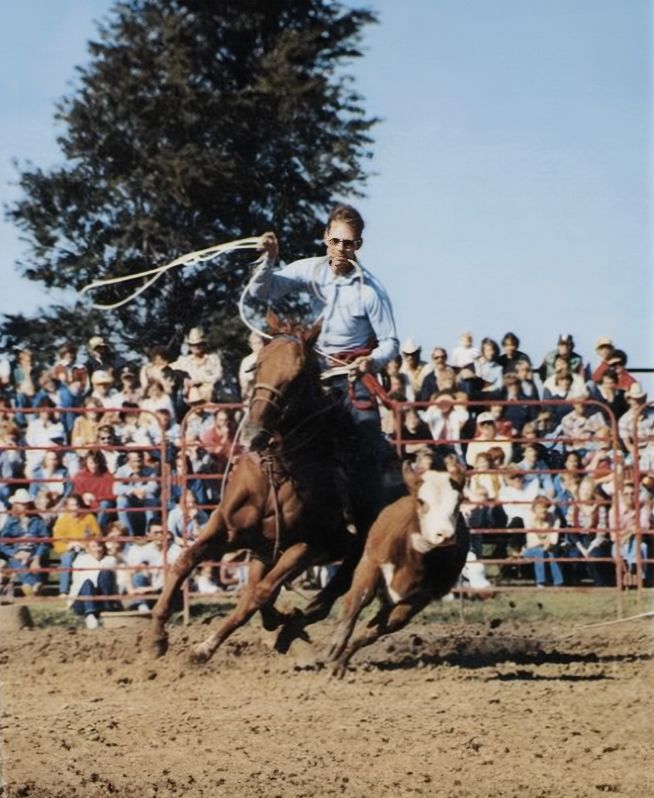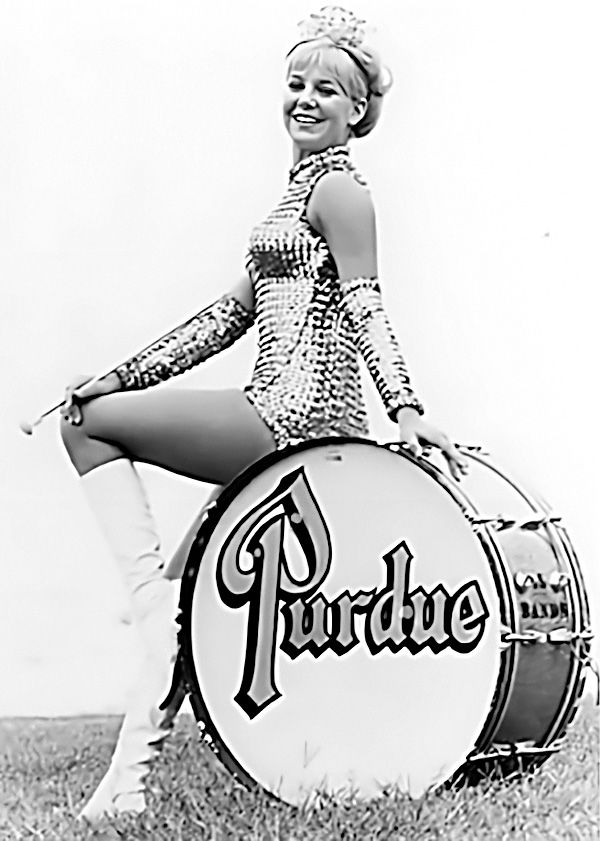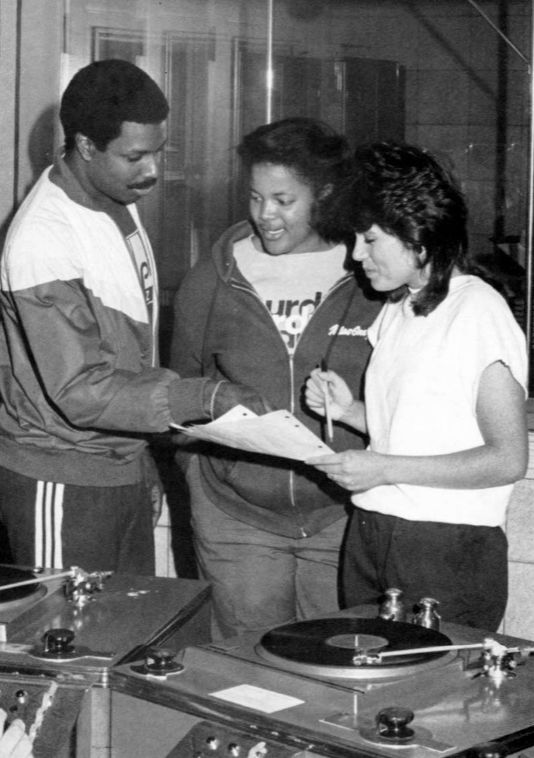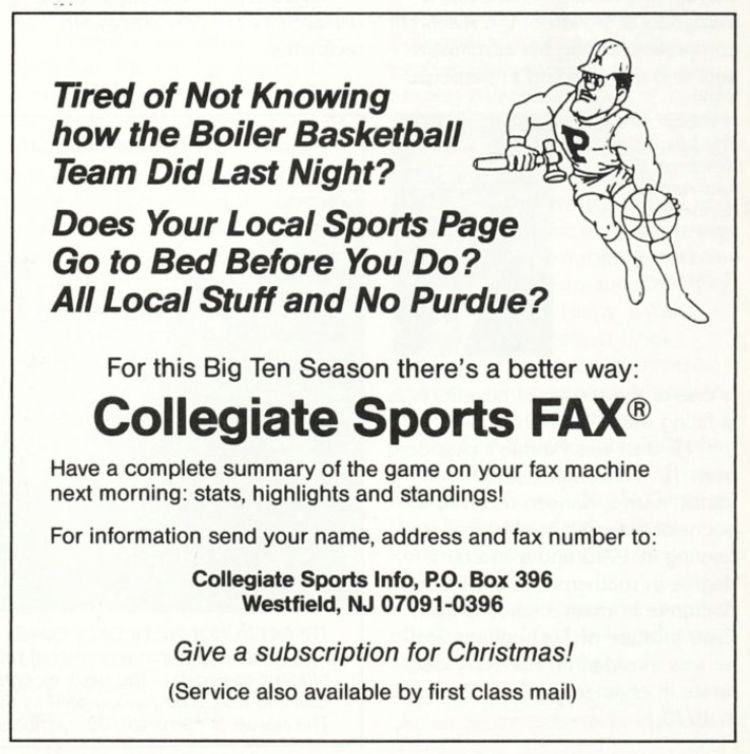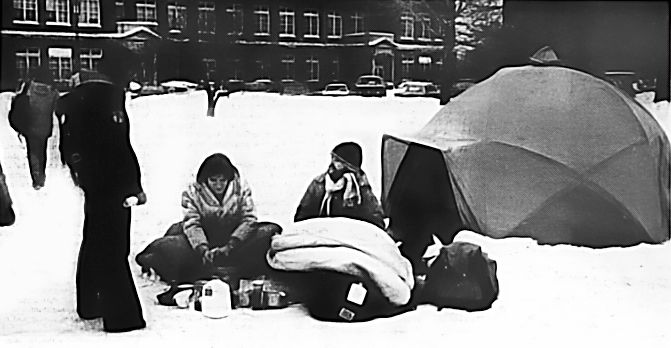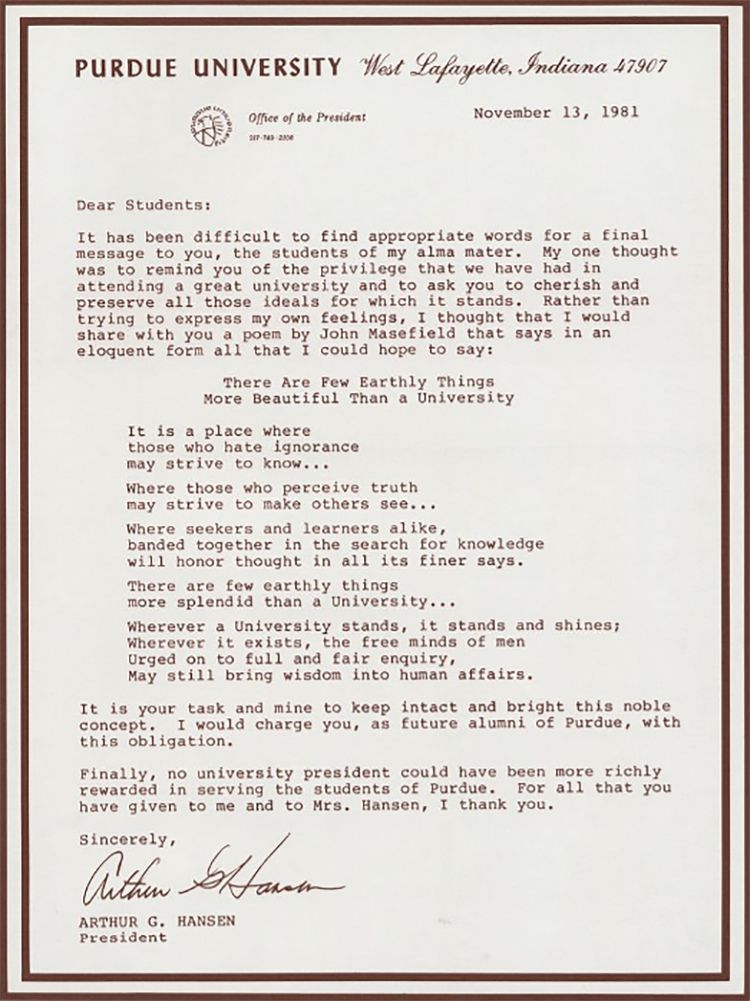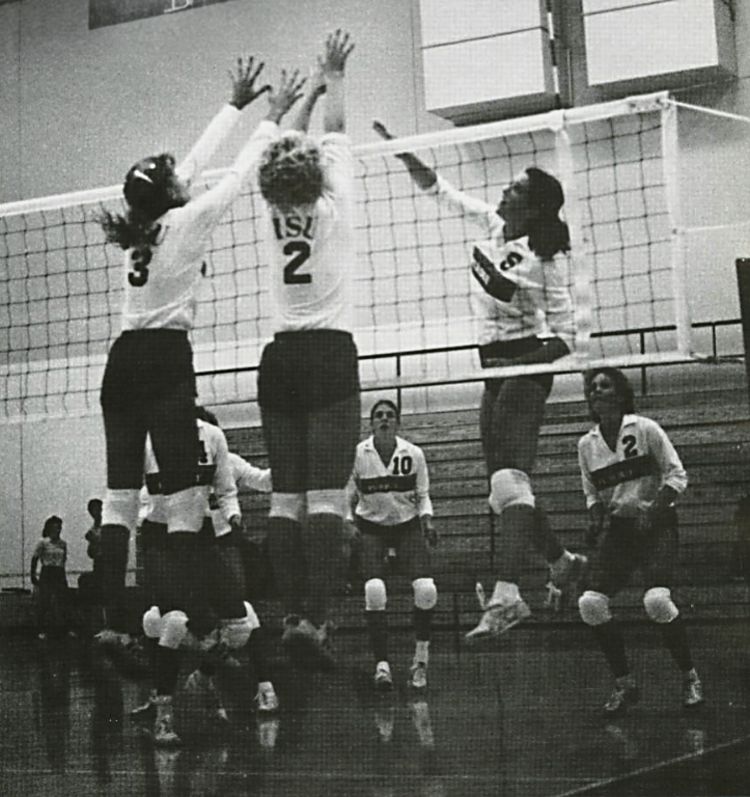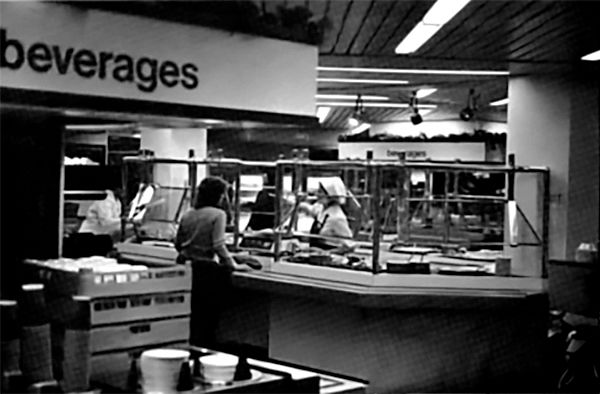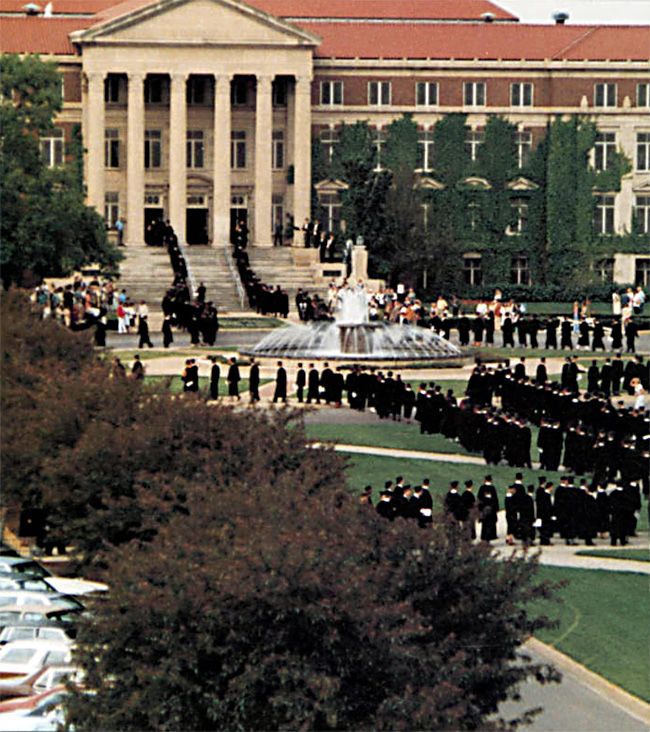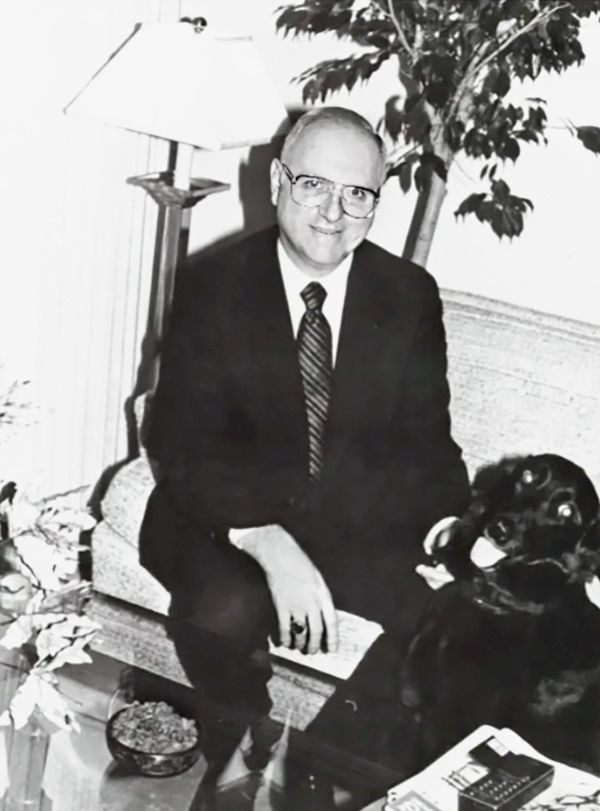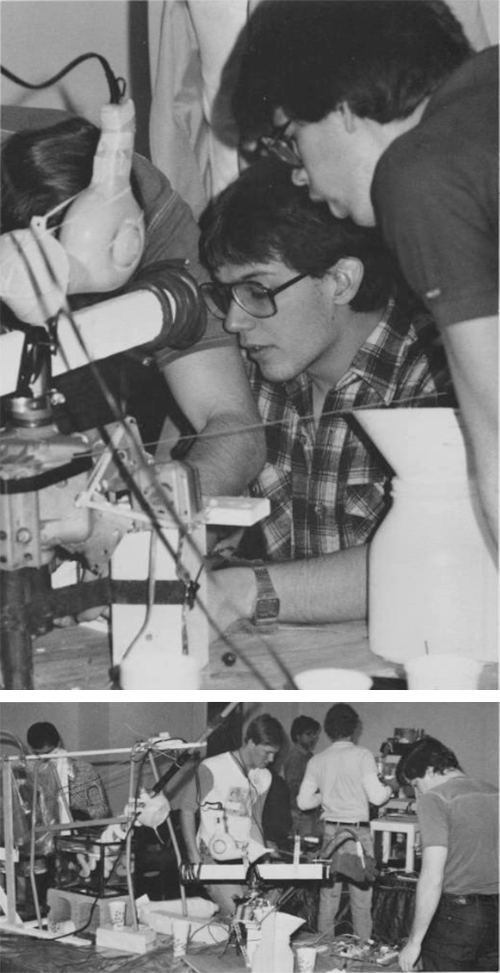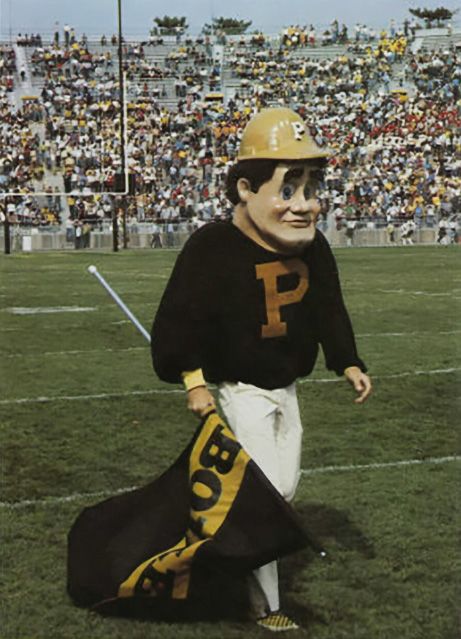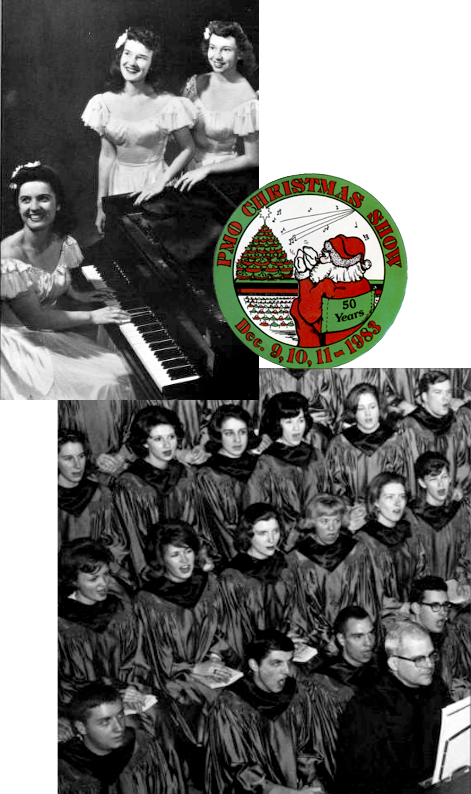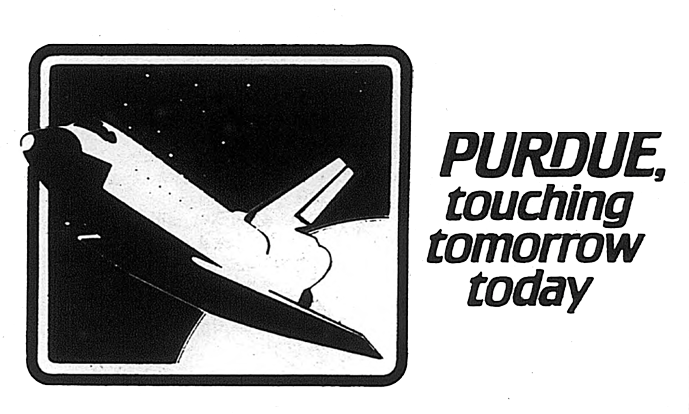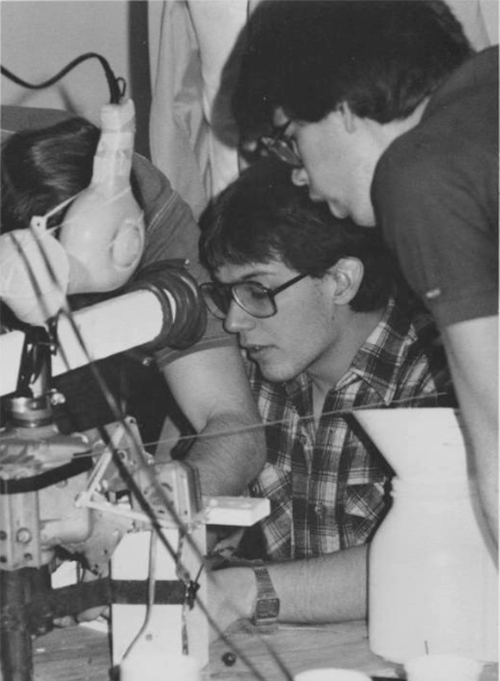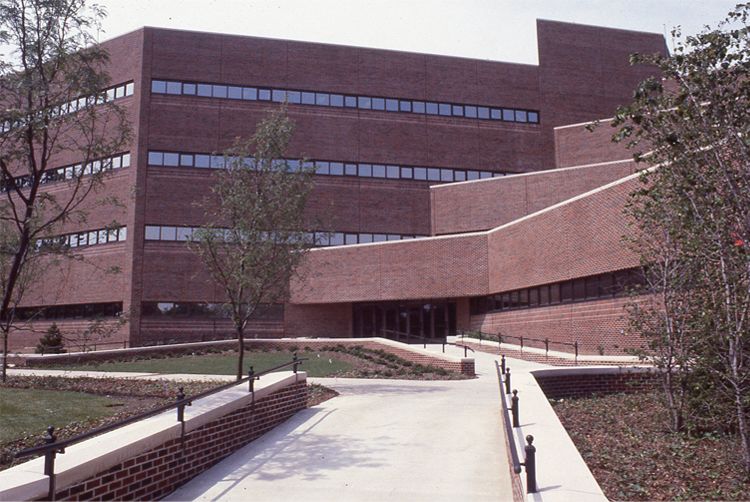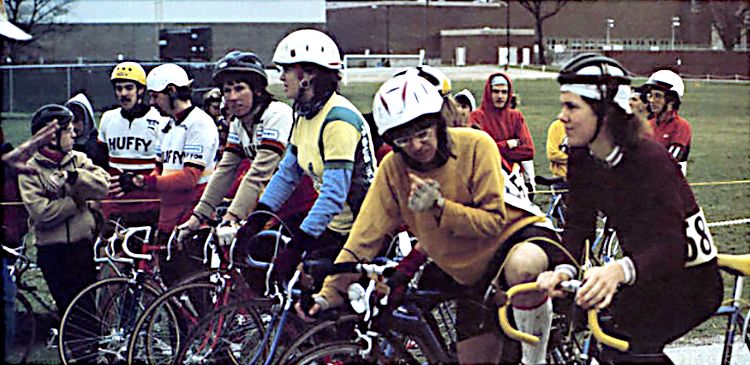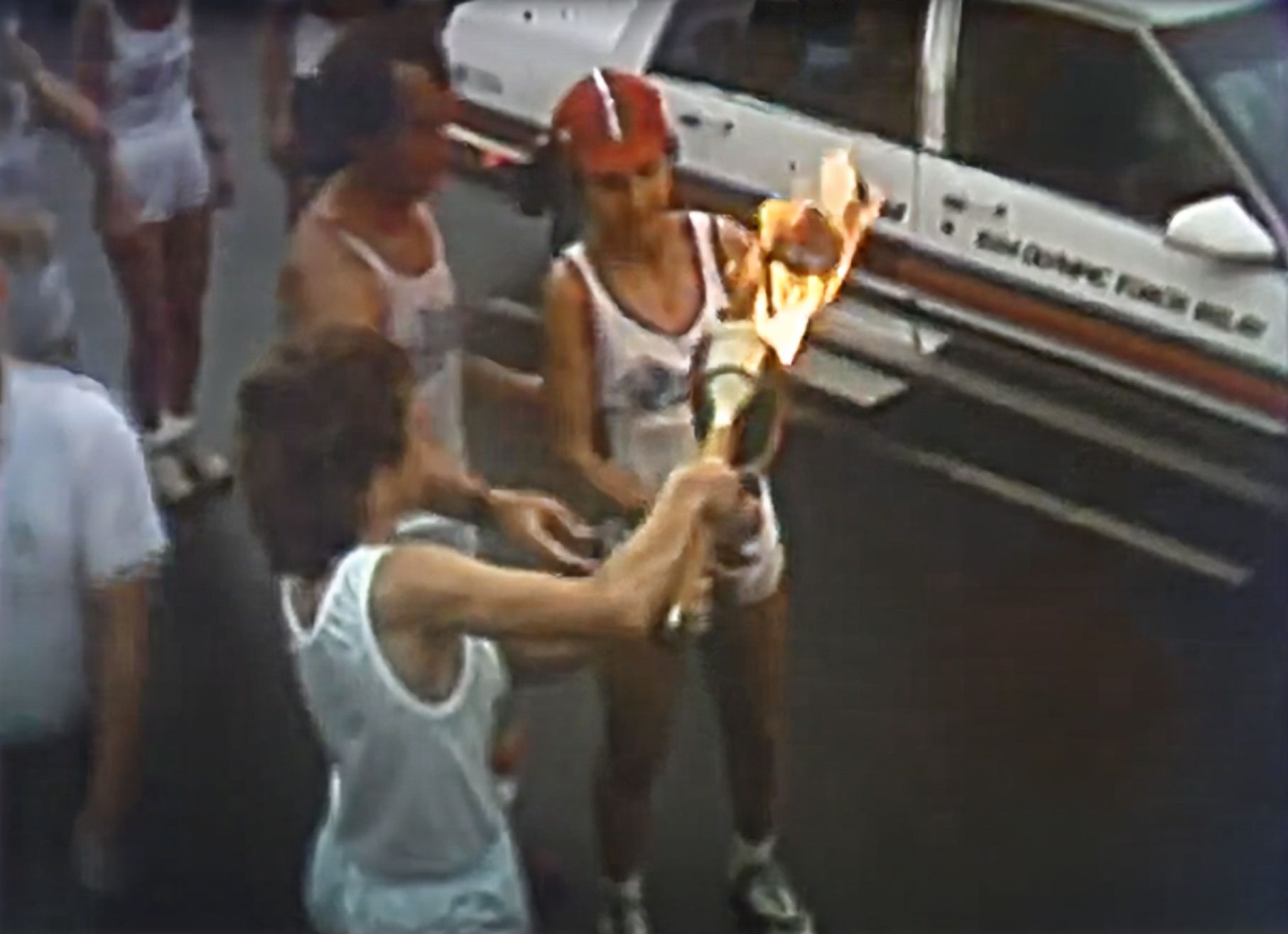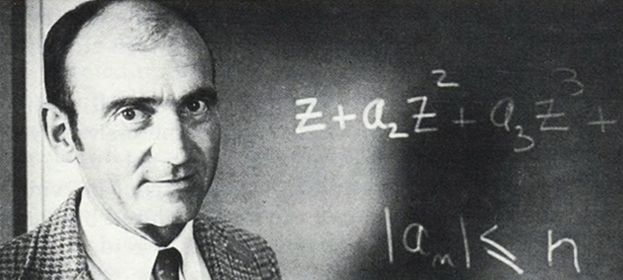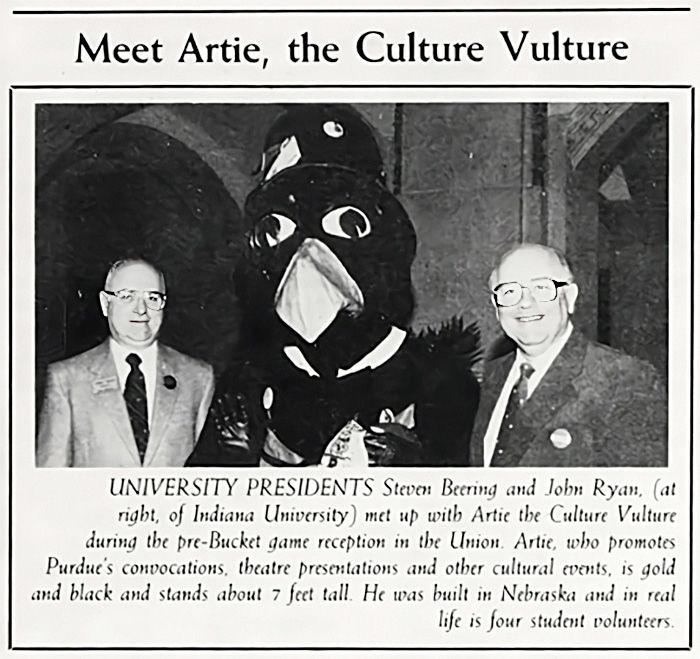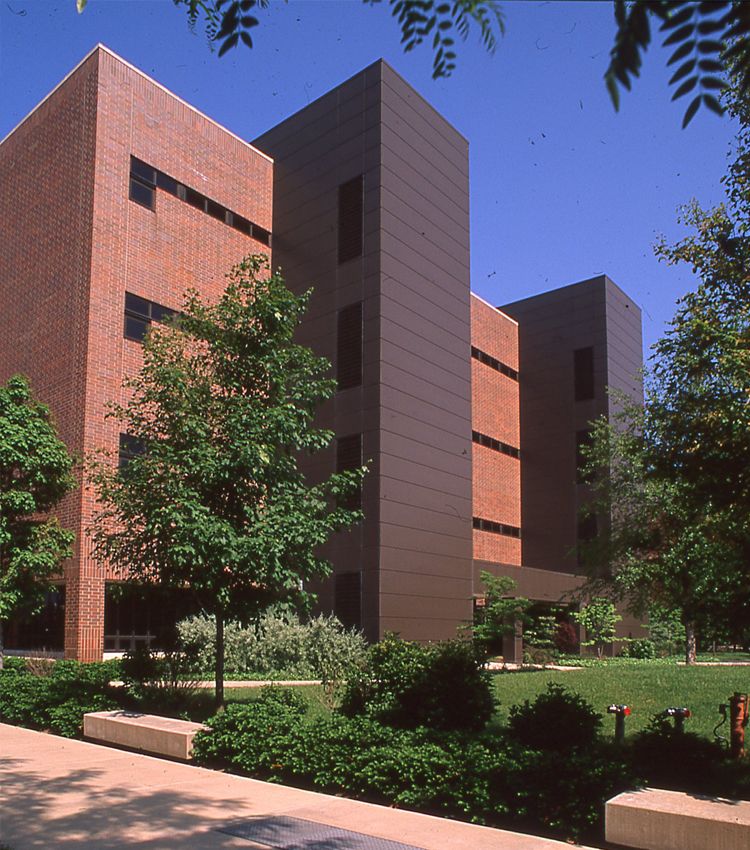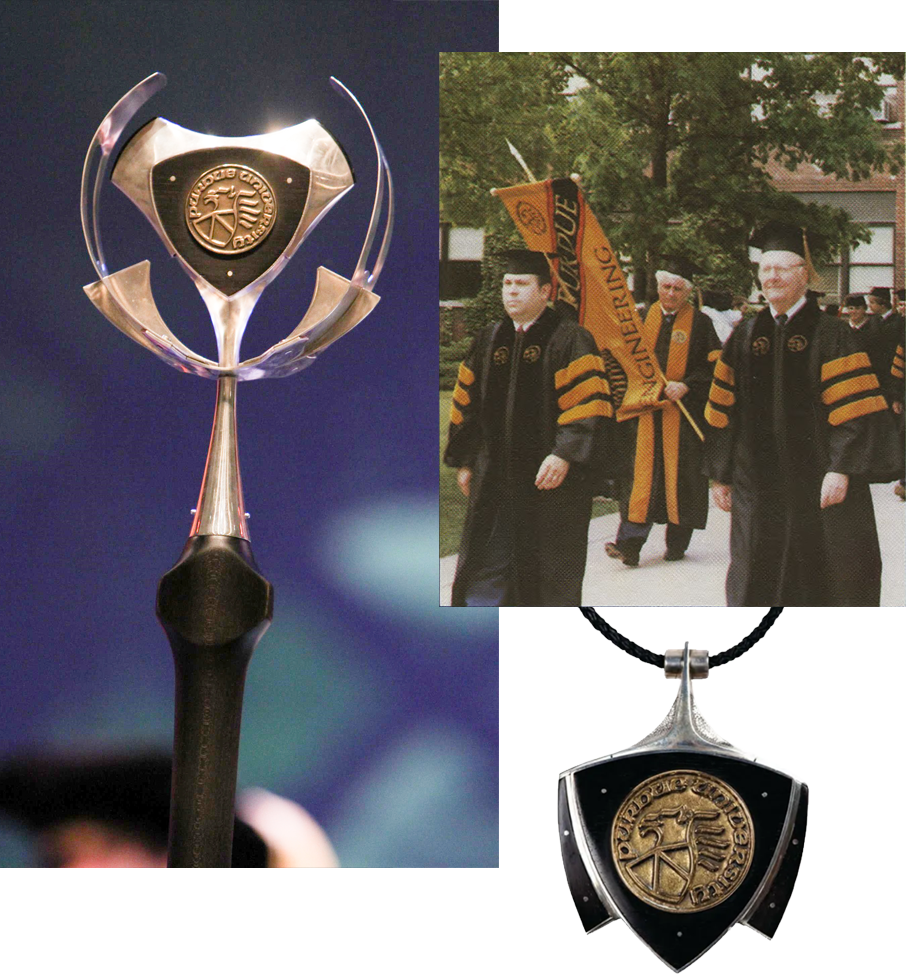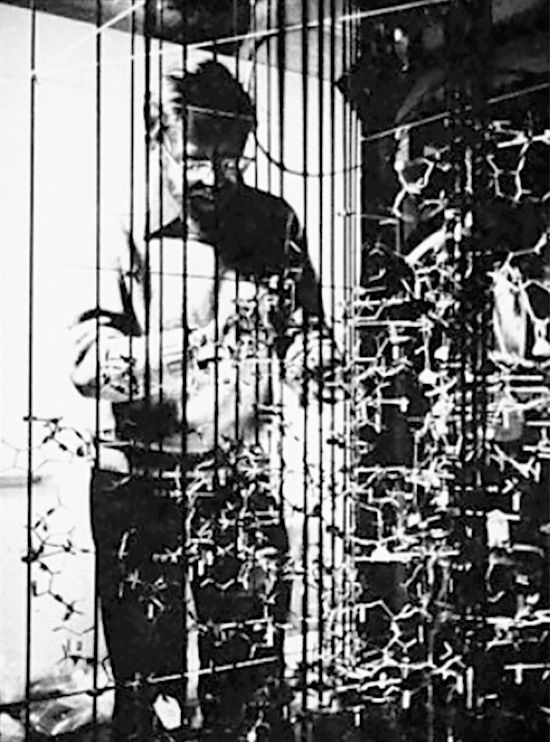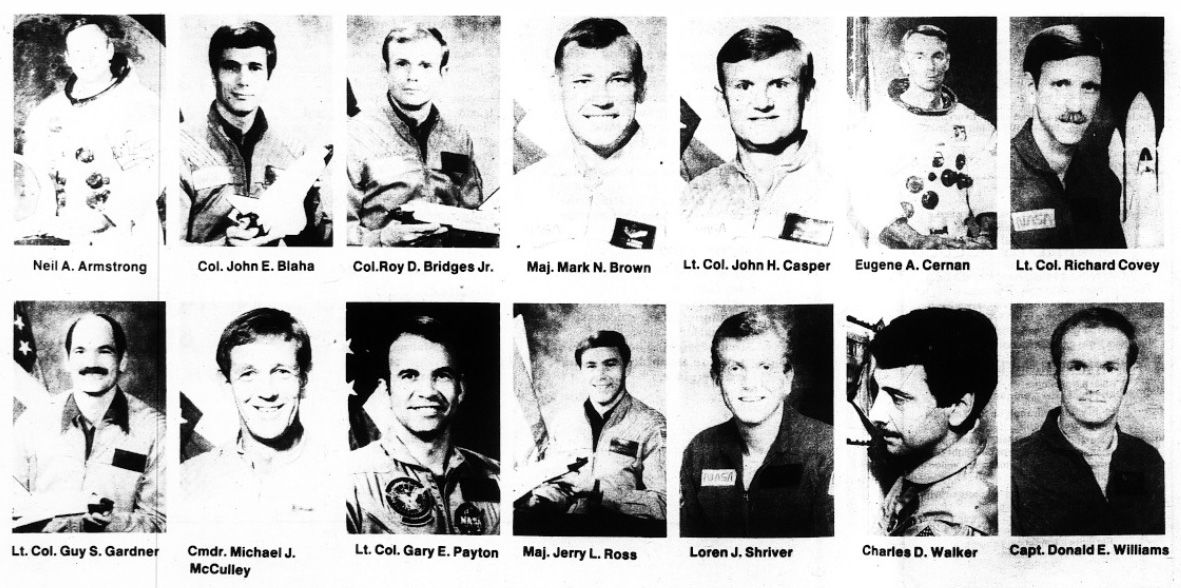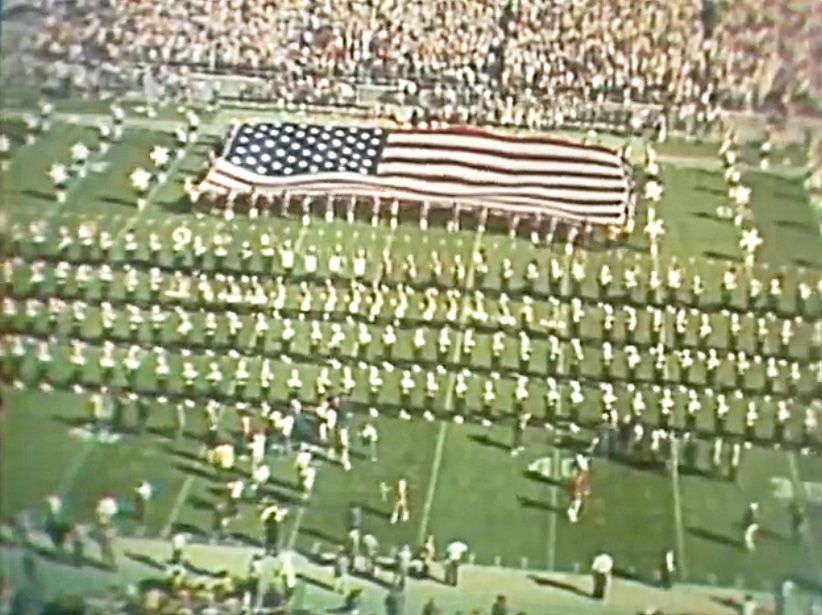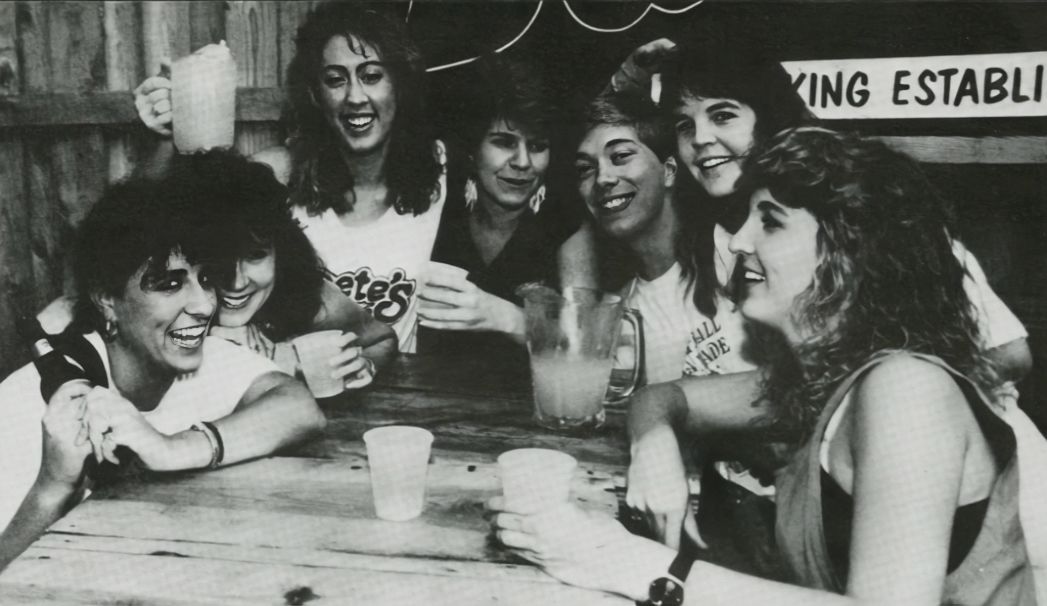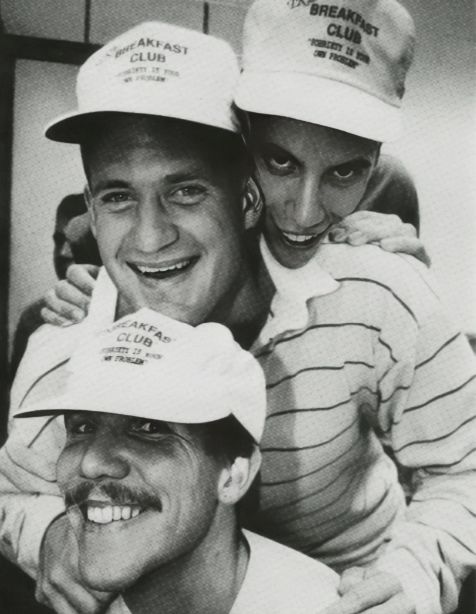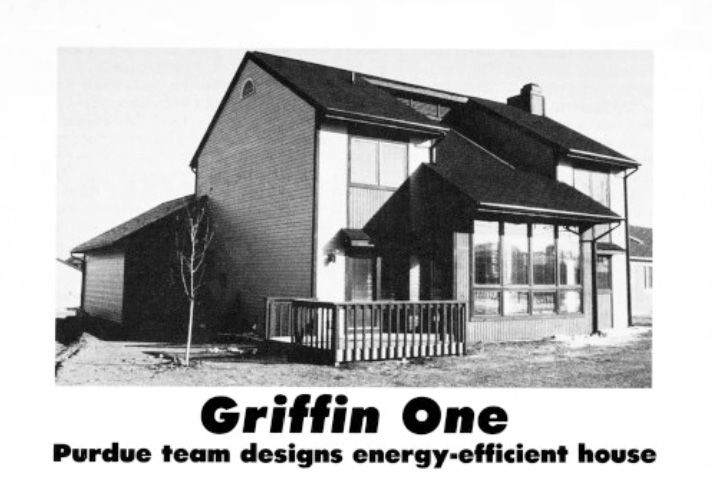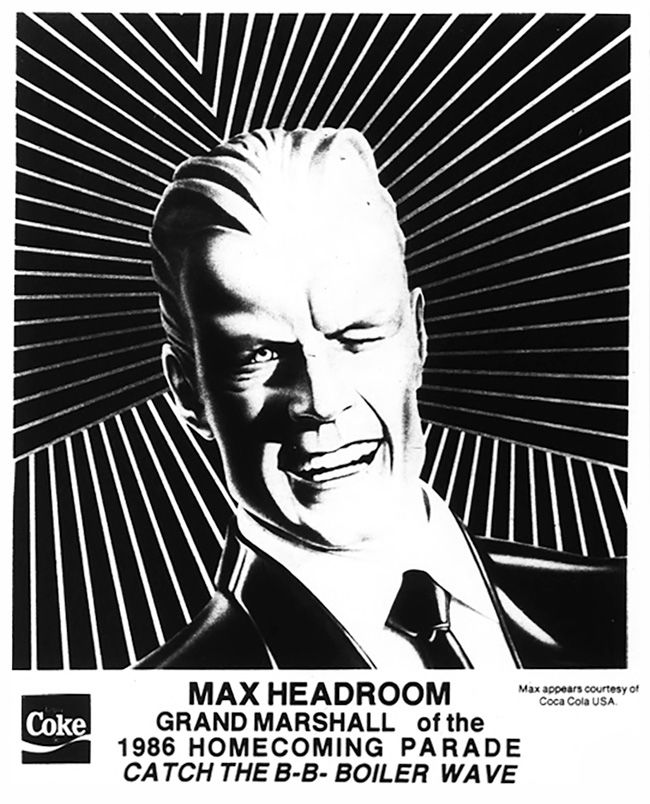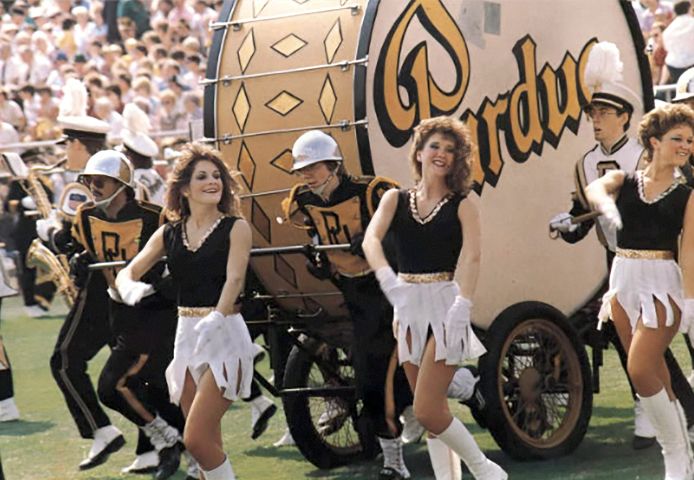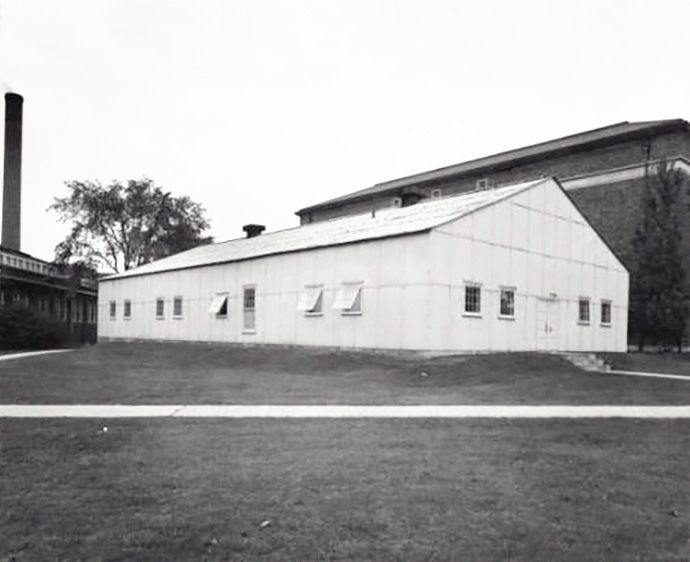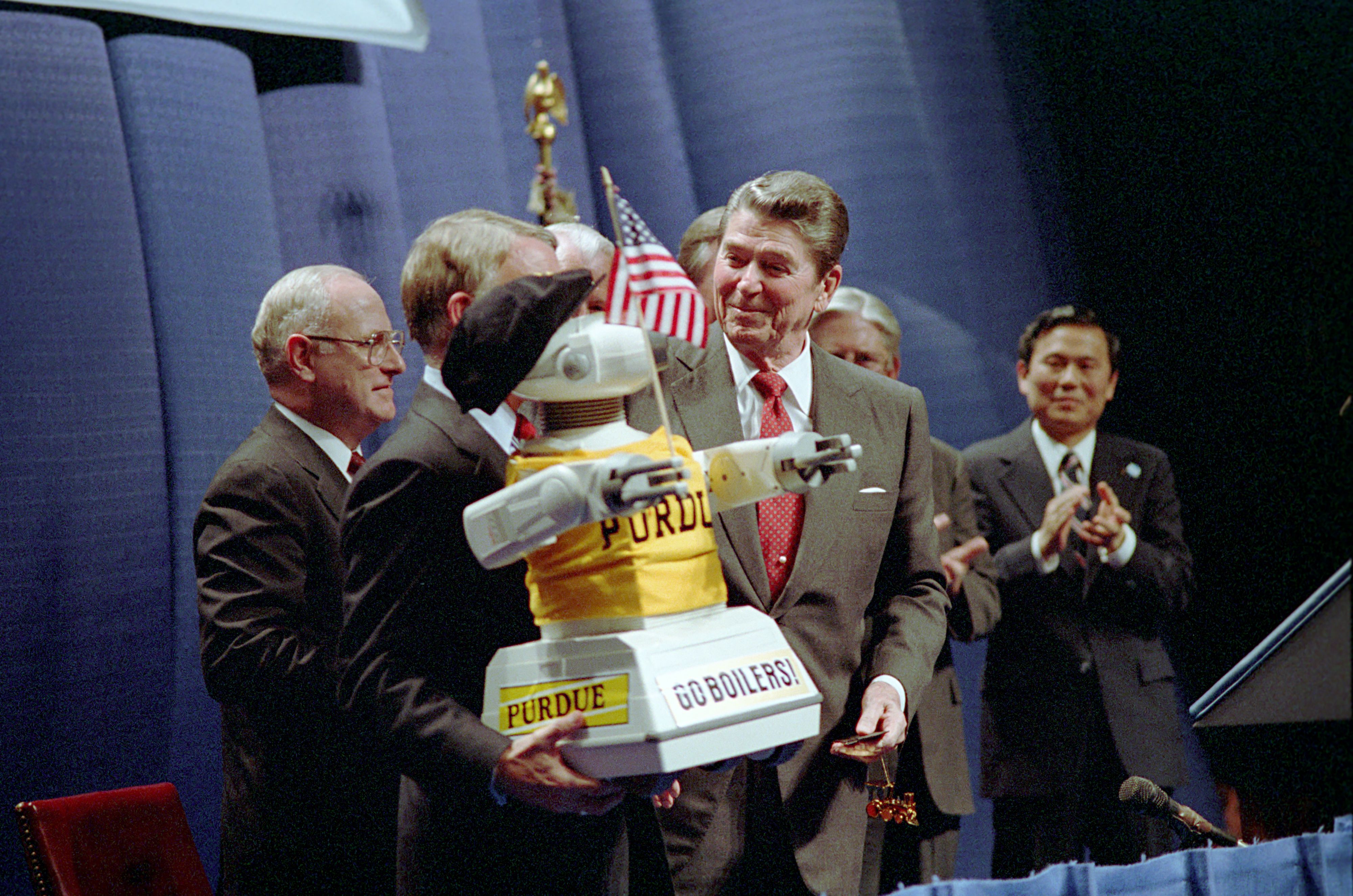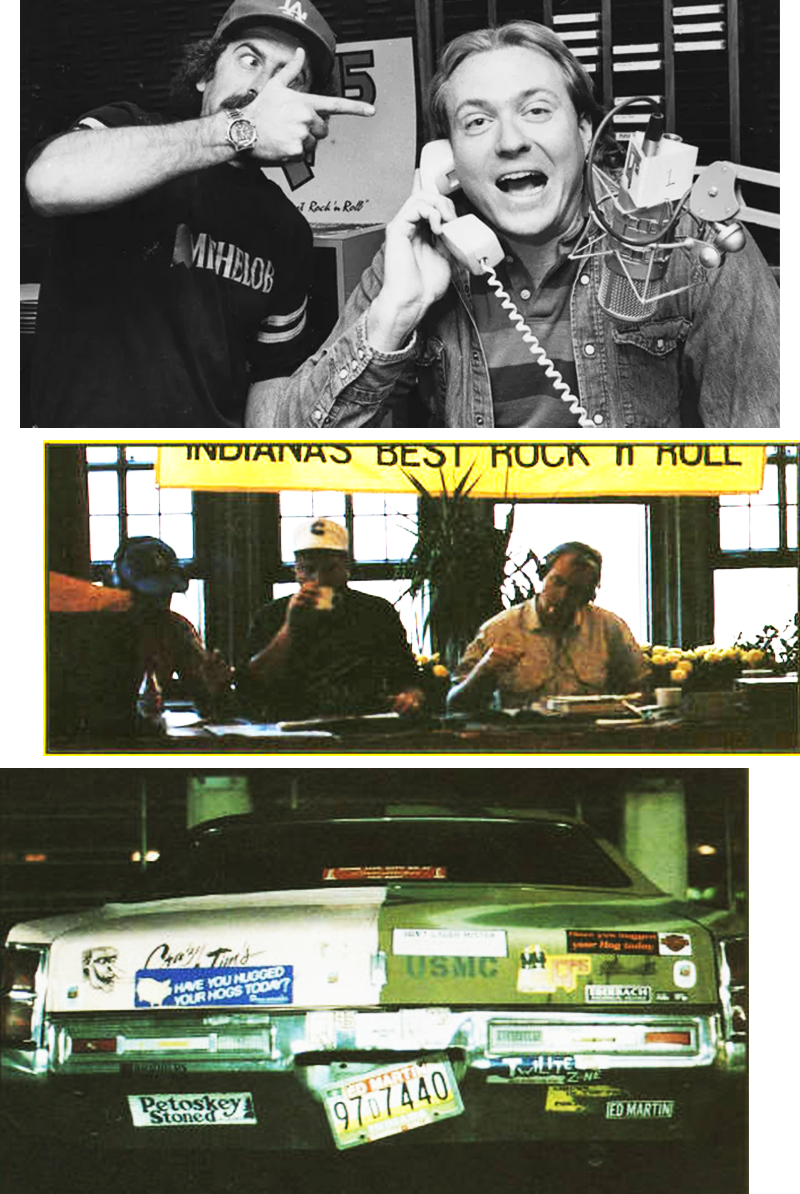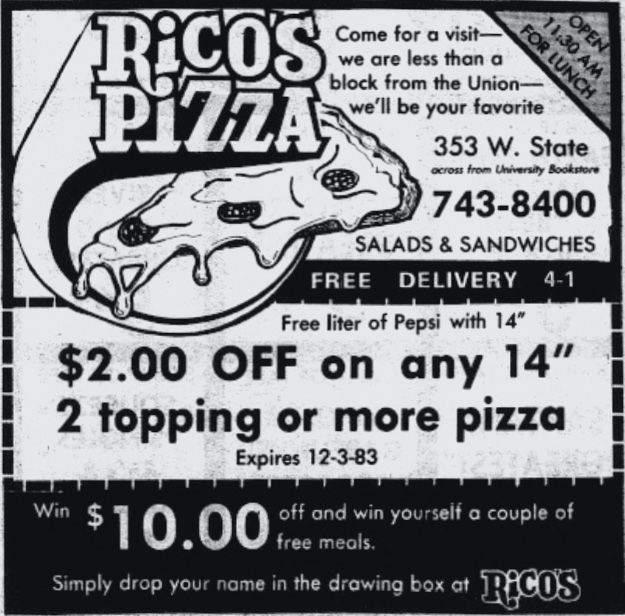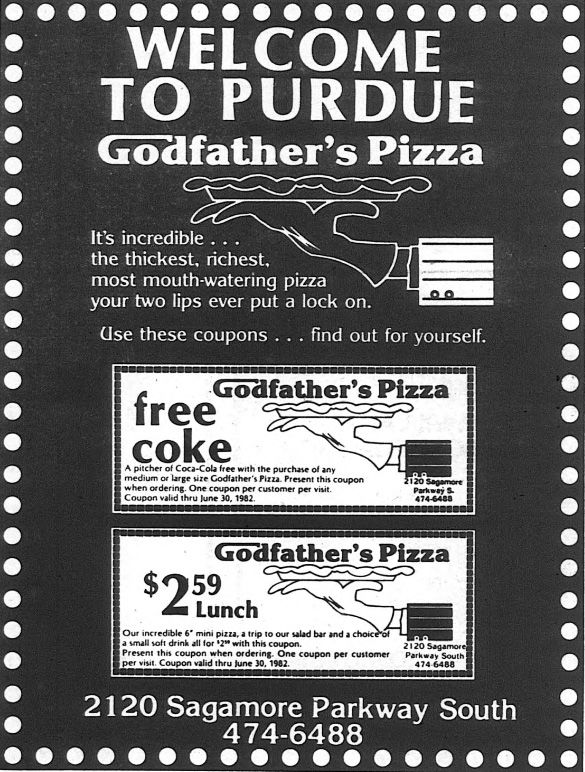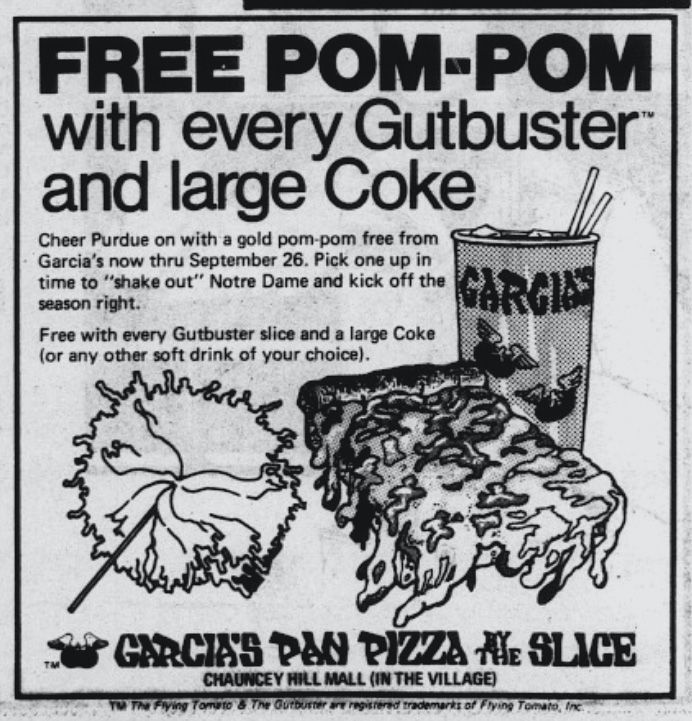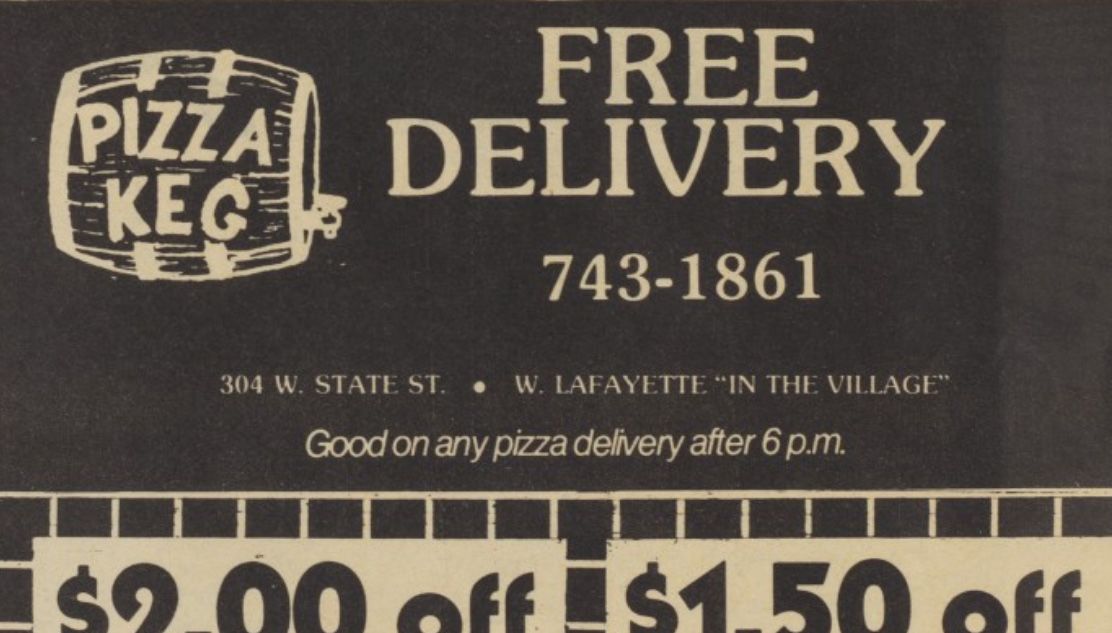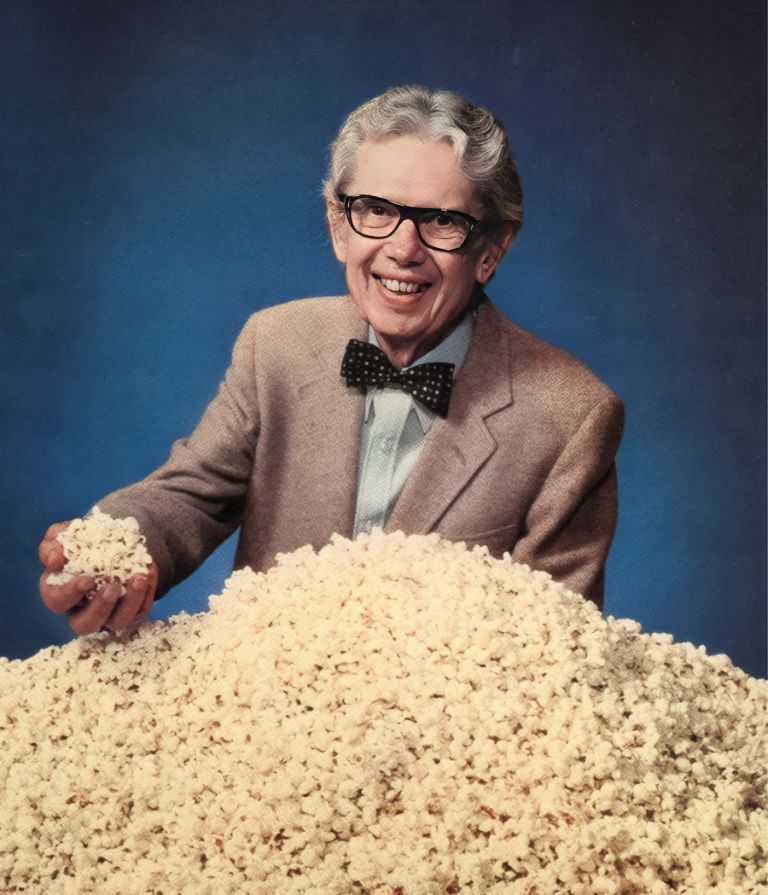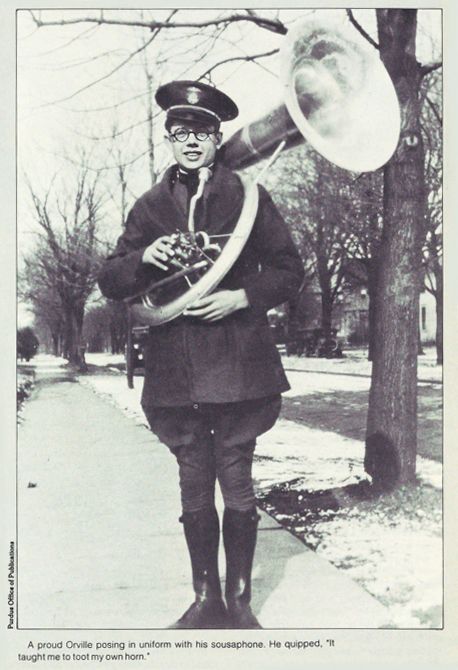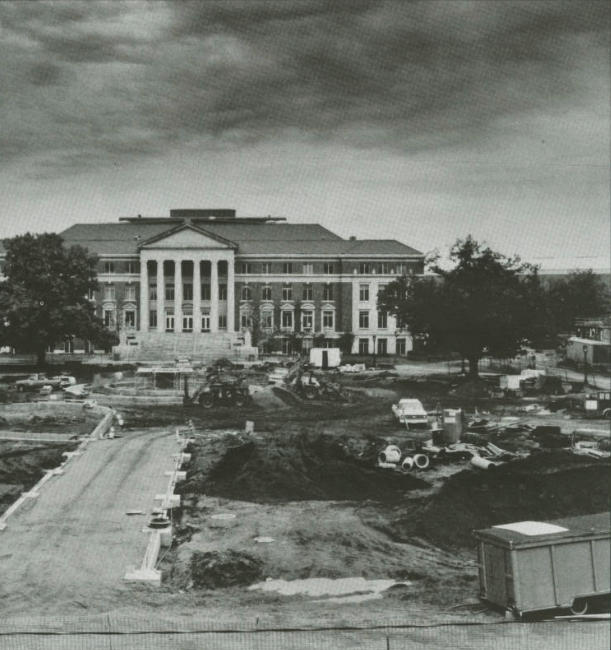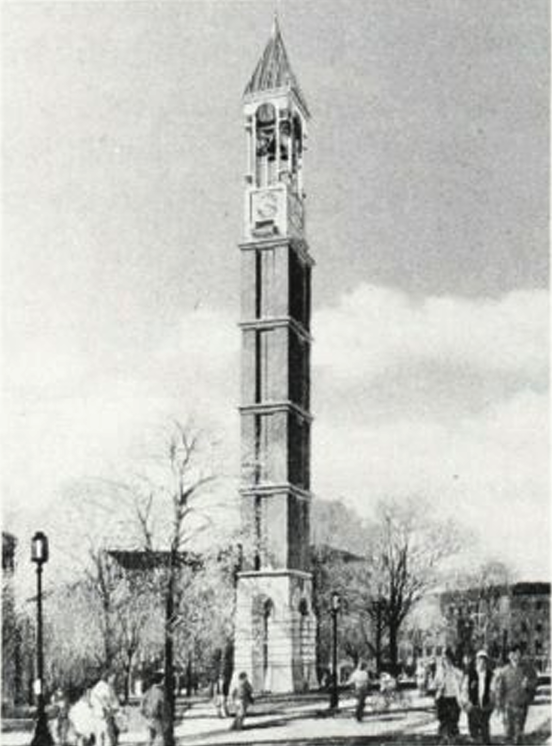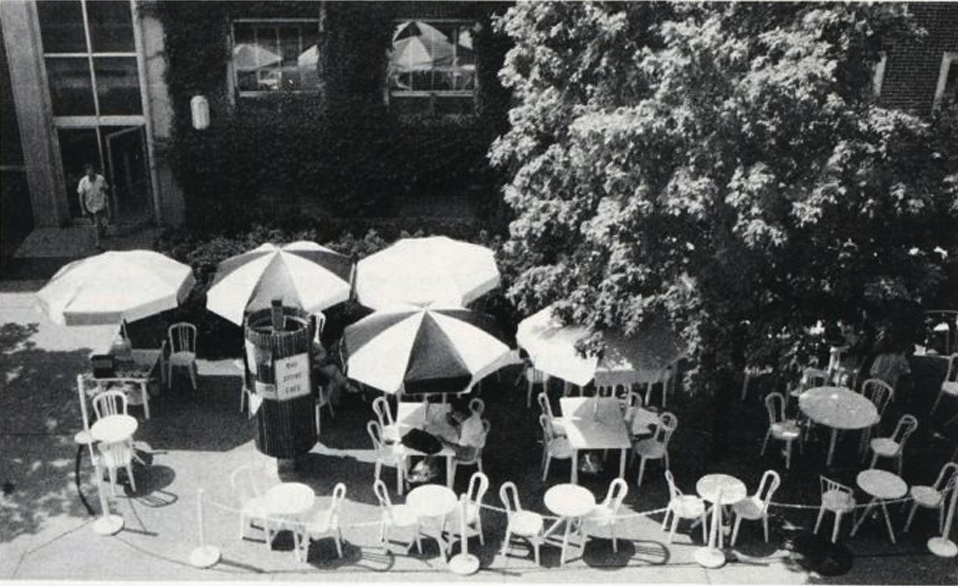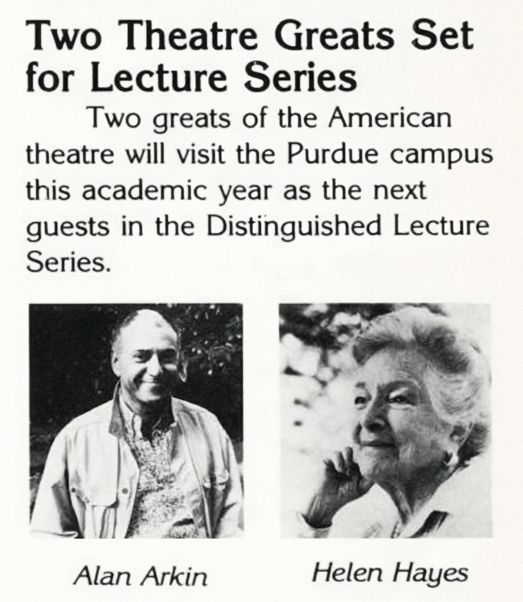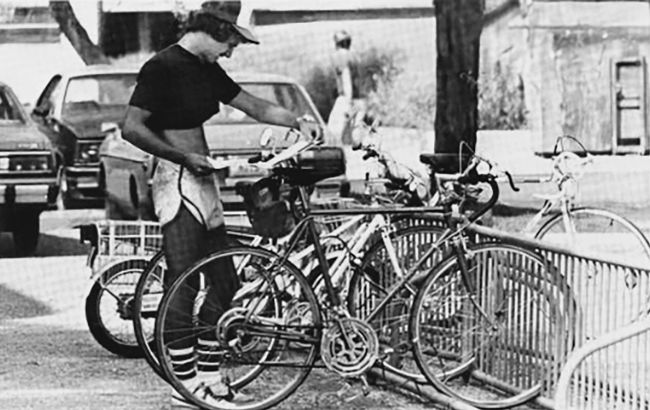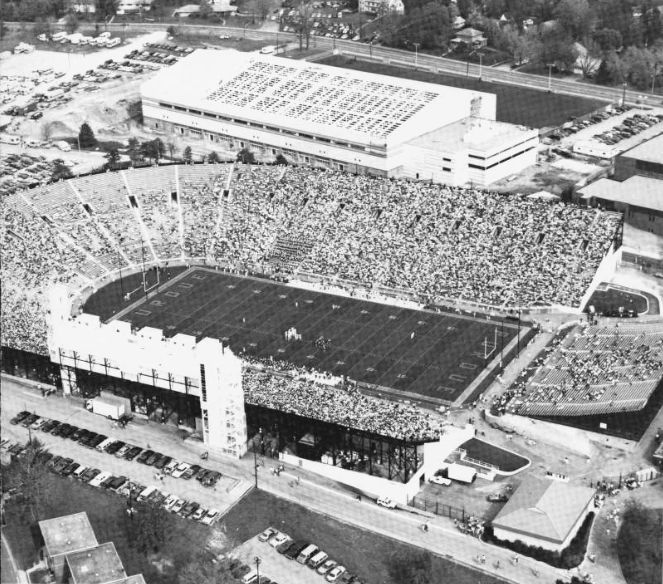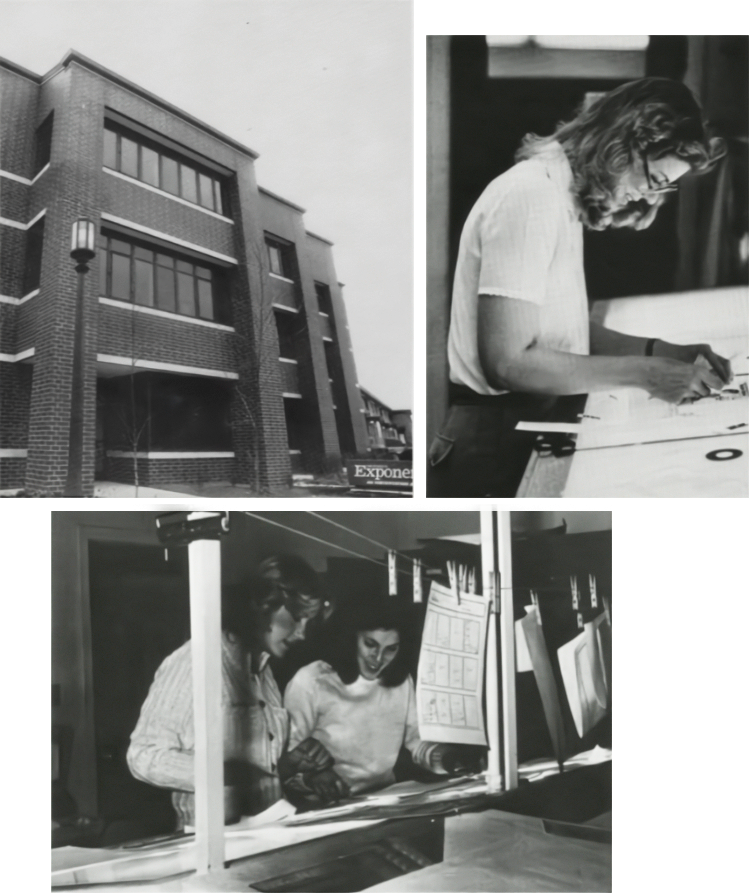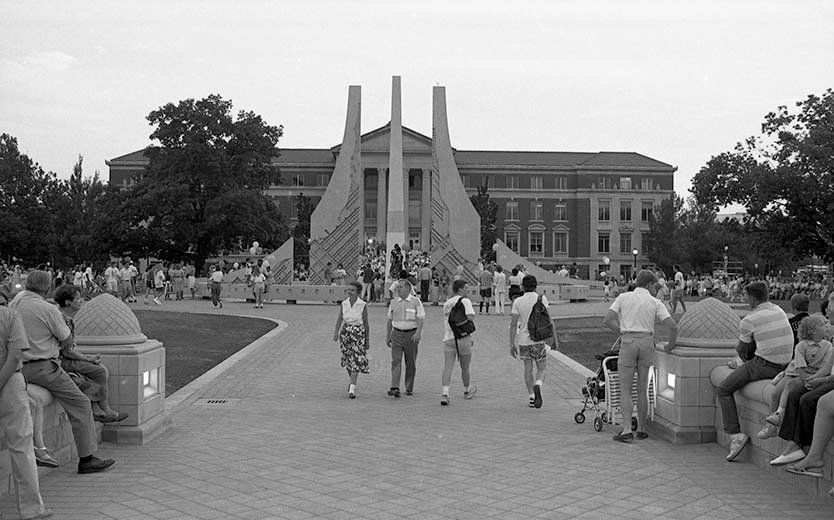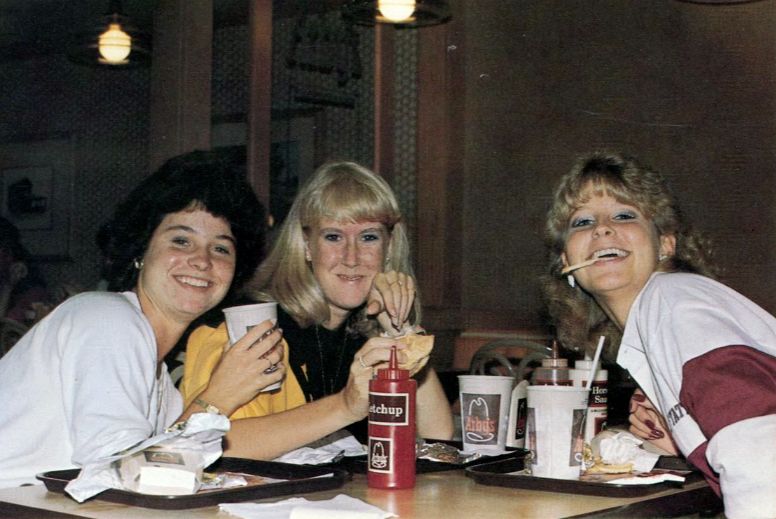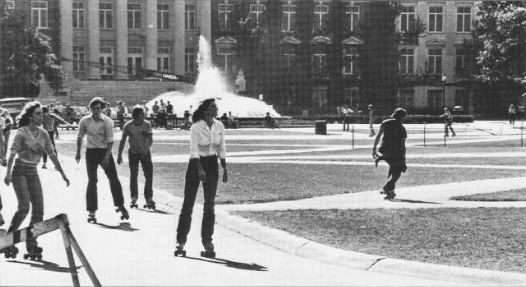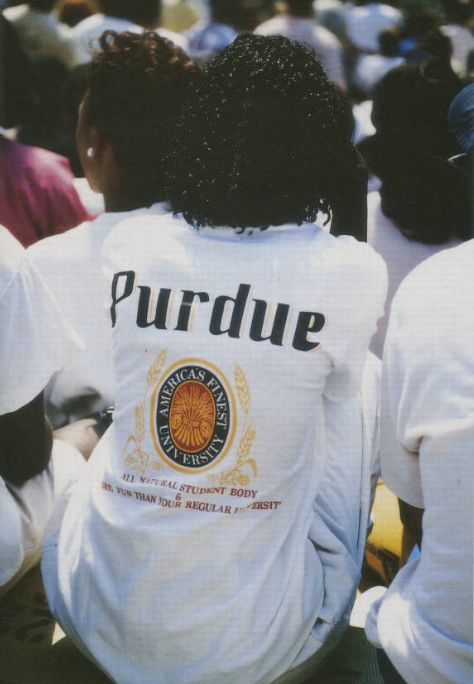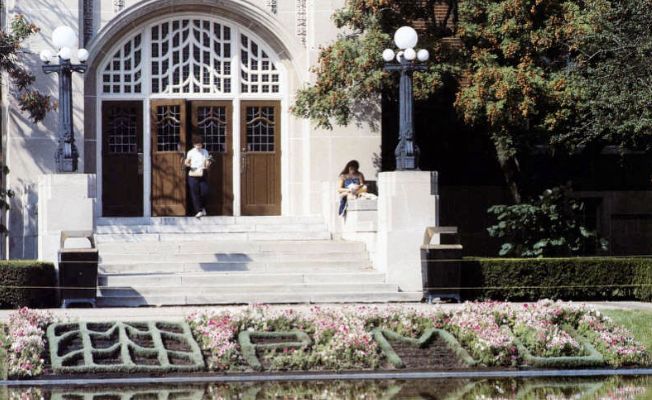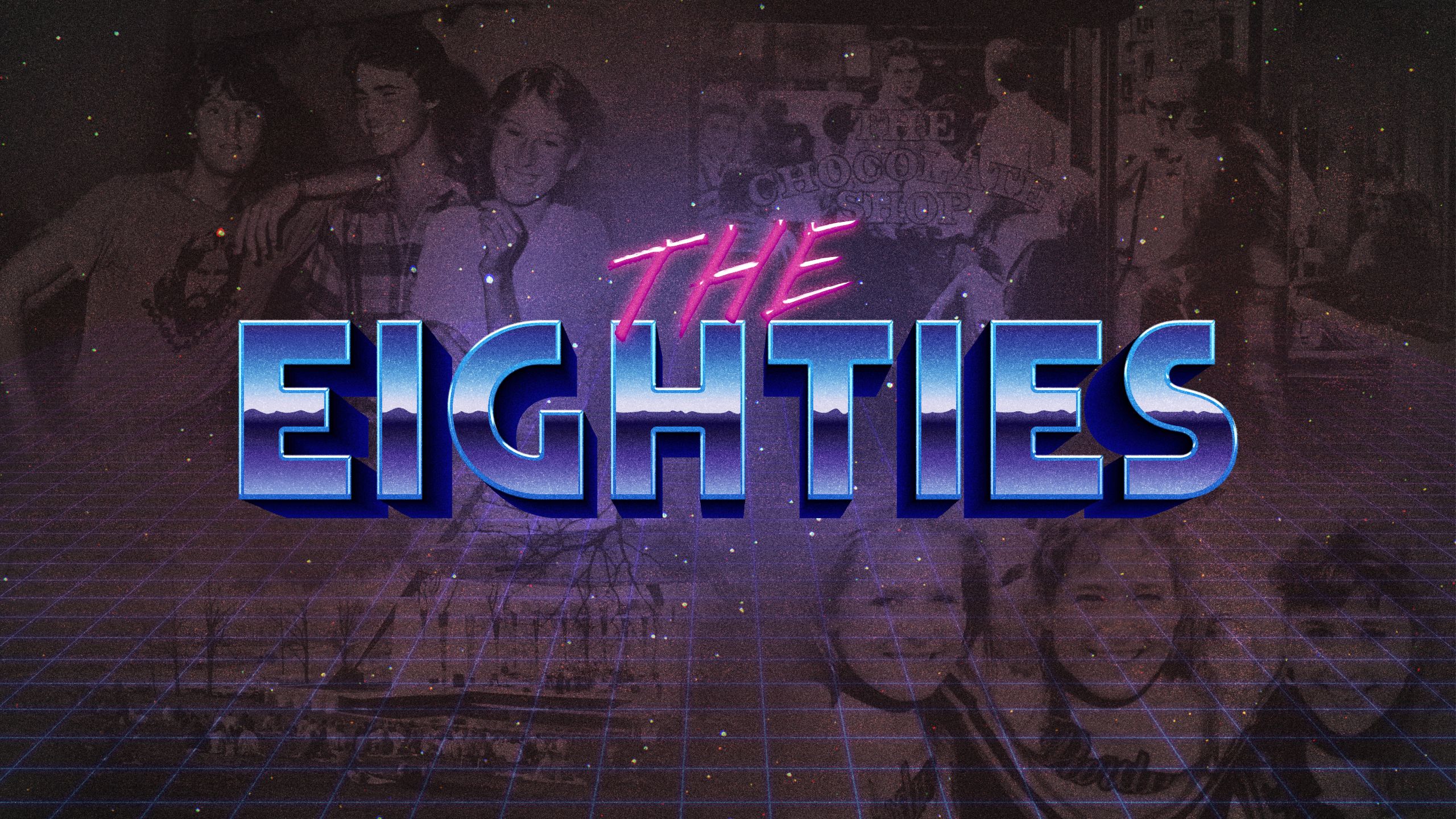
// Compiled by Mary Monical
It was an era of Pac-Man and punk rock. The Berlin Wall fell, mohawks made a point, and personal computers revolutionized the world. Newborns became millennials, and economic and political changes shifted the cultural landscape across college campuses.
Here, we present a smattering
of Purdue happenings
from the 1980s.

Enrollment hit a record 32,366.
The men’s basketball team made it to the Final Four, and Gene Keady began his career as Purdue’s all-time-winningest basketball coach.
Purdue kicked off its Plan for the Eighties capital campaign with a focus on advancement in science and technology. This was only the second time that the university had sought private capital funding. The campaign was organized to finance a life sciences laboratory building; an addition to the Civil Engineering Building (now the Delon and Elizabeth Hampton Hall of Civil Engineering); a School of Technology building; and the endowment of special research efforts and distinguished professorships in science, engineering, and technology.
The 50th U-Sing, a musical competition between Purdue housing units and student organizations, was held in Elliott Hall of Music.
Journey performed on campus thanks to student David Huxhold (HHS’80), who won a contest sponsored by Columbia Records and Ampersand magazine. The contest rewarded the college with the best community service program, and Huxhold submitted Purdue’s curb cutting project, which provided increased accessibility on sidewalks and streets.
A performance by comedian Andy Kaufman marked the first time that the Student Concert Committee had attempted anything other than a musical program.
After fans clamored for a tougher athletic mascot, a fierce-looking Purdue Pete was introduced with a much lighter head than he had sported in the ’70s (reports vary about the weight—some say 47 pounds, others say as much as 90 pounds). Gone was the youthful papier-mâché and plaster noggin; taking its place was a 10-pound fiberglass construction with a more formidable expression.
Purdue Alumnus
Purdue Alumnus
Debris
Debris
Debris
Debris
Debris
Debris
Left: Purdue Exponent. Right: Debris
Left: Purdue Exponent. Right: Debris
Debris
Debris
Debris
Debris
Purdue University
Purdue University
Debris
Debris
Purdue’s Plan for the Eighties capital campaign surpassed its $34.2 million goal.
The Recreational Gymnasium, or Co-Rec, expanded its footprint with 21 new racquetball and handball courts and a large gymnasium that could be divided into three basketball courts.
The first Boilermaker Rodeo was held over three days to raise money for student scholarships and campus and community development projects. Organized by the Boilermaker Tractor Pull Foundation and the Boilermaker Rodeo Club, the event featured Wild West entertainment, bull riding, bronc riding, and barrel racing.
Al. G. Wright, Purdue’s second director of bands, retired after 27 years in the role. He is credited for adding auxiliaries to the marching band, including the Golden Girl, Girl-in-Black, Silver Twins, Flag Corps, and Golduster Dance Team.
A campus housing shortage forced the university to turn all spare store rooms and service areas in residence halls into living spaces. In addition, nearly 900 undergraduates had to be housed in the Hawkins and Young graduate buildings.
Soul Plus Magazine began broadcasting a weekly radio program from the basement of Elliott on WBAA. Leonard Perry, assistant dean of students and host of the show, originated the program in order to “fill a void that existed in addressing Black concerns, issues, and interests.” Student announcers selected topics of discussion and were responsible for researching and producing the features.
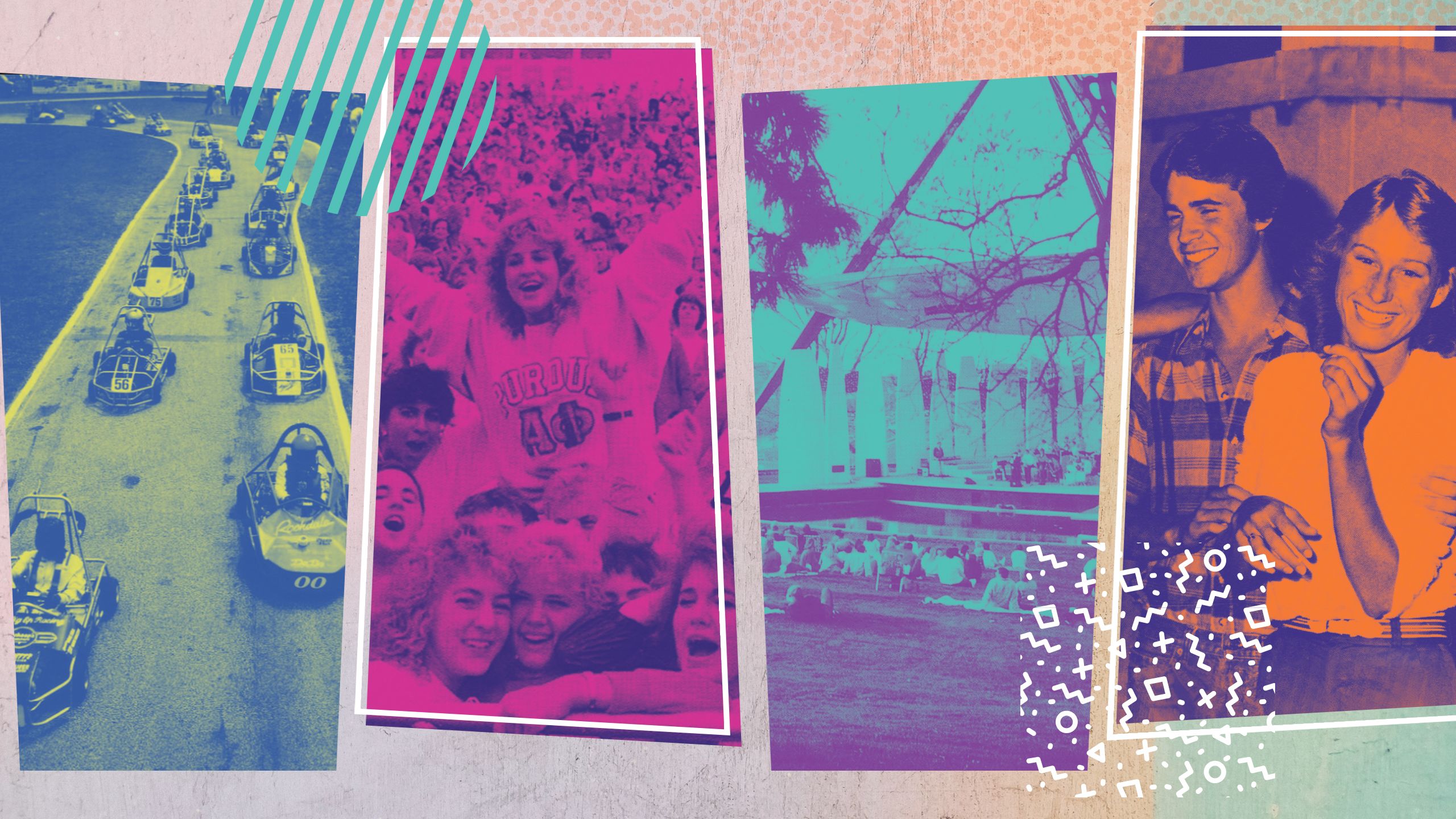
FAX IT TO ME
Boilermaker sports fans could once sign up for a service that provided game highlights, stats, and standings—via fax!
Snow and subzero temperatures caused the university to cancel the first day of classes in January. It was only the third time in 32 years that classes had been canceled due to weather conditions. The severe weather continued through January, and members of the Purdue Outing Club took advantage of the challenges of nature by camping outside on Memorial Mall.
Arthur G. Hansen (ECE’46, MS S’48, HDR E’70), the only Purdue graduate to serve as university president, retired. He announced his plan to leave the university in November 1981.
The Intercollegiate Athletic Facility (now the Drew and Brittany Brees Student-Athlete Academic Center) was completed. The building contains Holloway Gymnasium, which is home to the Boilermaker volleyball and wrestling programs.
The first Maymester program, sponsored by the Purdue Student Association and the Continuing Education administration, was held for three weeks with more than 300 participants.
The ground floor of the Purdue Memorial Union underwent a major renovation and reopened with new food options to replace the old cafeteria: Oasis, an updated Stripe Shop, and the Union Market.
The Undergraduate Library, renamed the John W. Hicks Undergraduate Library in 1989, opened in front of Stewart Center. An extensive student lobbying effort in the 1970s was instrumental in securing funds for the $9.5 million building.
A record 7,740 degree candidates were eligible to participate in May commencement exercises. For the first time, four ceremonies were held to accommodate the students and their families.
Purdue Exponent
Purdue Exponent
Debris
Debris
Debris
Debris
Debris
Debris
Debris
Debris
Debris
Debris
Debris
Debris
Debris
Debris
Debris
Debris
Debris
Debris
Debris
Debris
Purdue Exponent
Purdue Exponent
Steven Beering (HDR S’00) was selected as the ninth president of Purdue; he was the second to hold a medical degree.
Three undergraduate student experiments were sent into space aboard the Challenger VII space shuttle. Approximately 100 students had worked on the projects during the previous five years.
The Rube Goldberg Machine Contest—a popular event on campus in the 1940s and ’50s—was revived by members of the Theta Tau engineering fraternity.
The Krannert Center for Executive Education and Research opened, funded by a $3 million charitable grant from the Krannert Charitable Trust.
A friendlier Purdue Pete made his debut, featuring a smile and a hard hat.
A Control Data Corporation Cyber 205 supercomputer was installed in the basement of the Mathematical Sciences Building, making Purdue the second university in the U.S. to have such a machine.
The PMO Christmas Show celebrated its 50th anniversary with more than 30,000 in attendance.
The university slogan “Touching Tomorrow Today” was unveiled as the theme of Beering’s administration and a way to show Purdue’s association with space and interest in future technology.
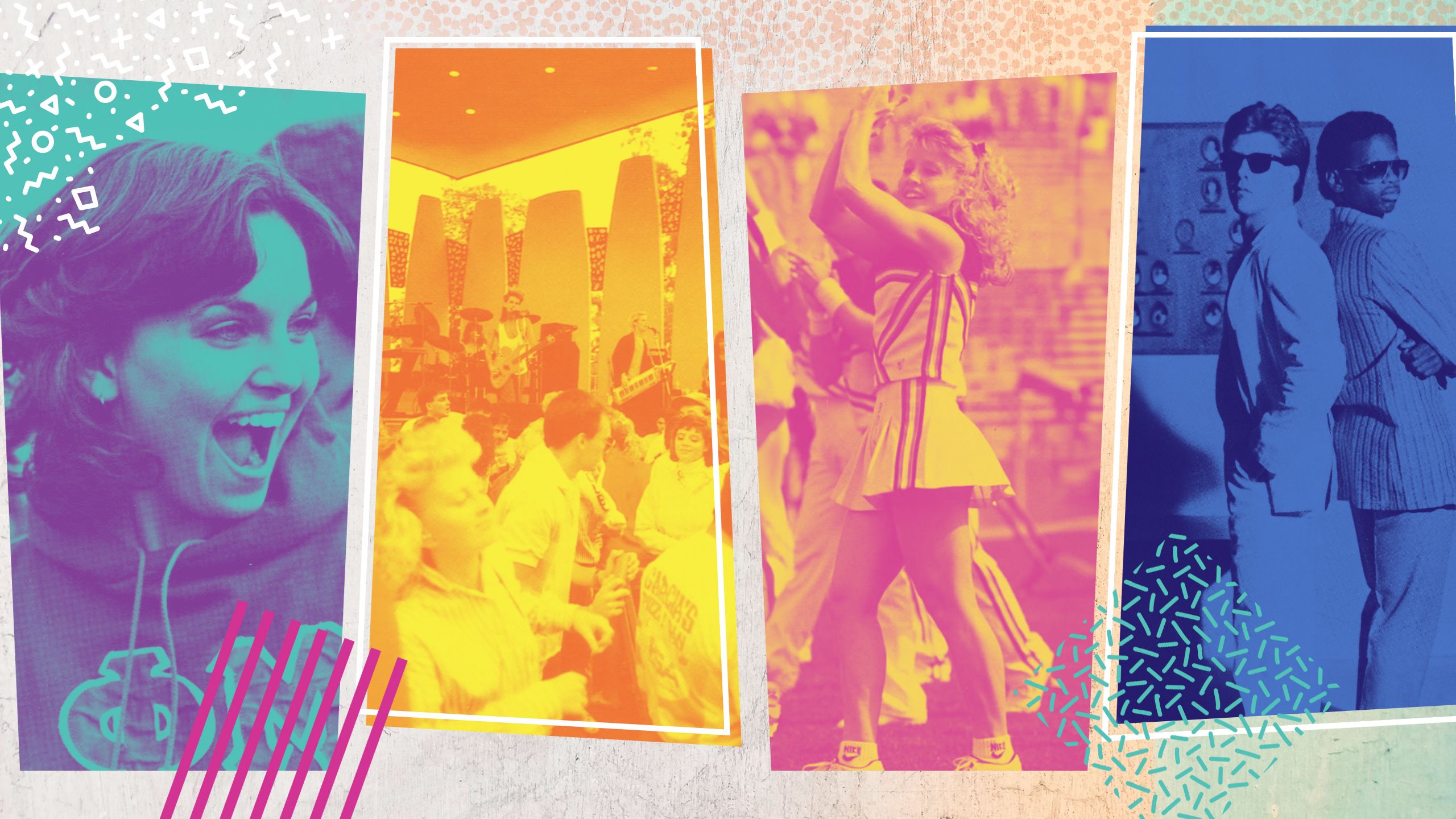
The $15 million Maurice G. Knoy Hall of Technology was dedicated, becoming the focal point for Purdue’s many technology programs. The Board of Trustees selected the name to honor a former trustee and board president.
The university held its first bike race, the Purdue Criterium, sponsored by the Purdue Bicycle Racing Club. The 0.8-mile race included four categories: novice, women’s, and two men’s United States Cycling Federation races.
Participants in the Olympic Torch Relay passed the torch in front of the Electrical Engineering Building (now the Max W & Maileen Brown Family Hall) on their way to the Summer Olympic Games in Los Angeles. Several students competed for spots on the U.S. Olympic team, and some Purdue staff and band members took part in the LA festivities.
Phi Sigma Rho, the first social sorority for women in engineering and technology, was founded by Purdue students.
Louis de Branges, a professor of mathematics, made history when he proved the Bieberbach conjecture, a problem that had challenged mathematicians since 1916. The discovery was hailed as the mathematical equivalent of climbing Mount Everest.
Purdue Convocations presented campus with its official mascot, Artie the Culture Vulture. Costumed in gold and black tails, a top hat, and a monocle over his right eye, he was a connoisseur of the performing arts and promoted cultural events at the university. Four student volunteers took turns wearing the outfit, which was created by a former Purdue professor at the University of Nebraska.
Debris
Debris
Purdue Newsreel
Purdue Newsreel
Purdue Alumnus
Purdue Alumnus
Purdue Alumnus
Purdue Alumnus
Purdue Alumnus
Purdue Alumnus
Purdue Alumnus
Purdue Alumnus
Purdue Exponent
Purdue Exponent
Purdue Newsreel
Purdue Newsreel
The Life Sciences Research Building was completed (it was renamed the Arthur G. Hansen Life Sciences Research Building in 1989 to honor President Emeritus Hansen).
At spring commencement, Purdue introduced fresh traditions: heraldic banners representing each school; robes for administrators in the new official Purdue gold color; a mace featuring the university seal for the grand marshal to carry; and a special medallion, also featuring the seal, worn by the president. The mace was designed by David Peterson, an assistant professor of art and design who taught jewelry and metalsmithing.
The National Science Foundation awarded the university $17 million to study and develop intelligent manufacturing systems.
Michael G. Rossman, the Hanley Distinguished Professor of Biological Sciences, generated excitement when he and his research team became the first to map the structure of a rhinovirus—a virus that causes the common cold—using X-ray crystallography.
Fourteen Purdue alumni astronauts, including Neil Armstrong (AAE’55, HDR E’70) and Eugene Cernan (ECE’56, HDR E’70), visited campus for a reunion during Homecoming. Purdue held its first Homecoming parade in nearly 60 years, and the world’s largest American flag—a gift from the John Purdue Club to the university—was unfurled during halftime. The tradition of a bonfire made its return to Homecoming festivities on Slayter Hill the night before the game.
Purdue biomedical researchers developed a pocket-sized electrocardiograph (EKG), or personal arrhythmia monitor, that could be used to make on-the-spot diagnoses to determine the cause of cardiac arrhythmias.
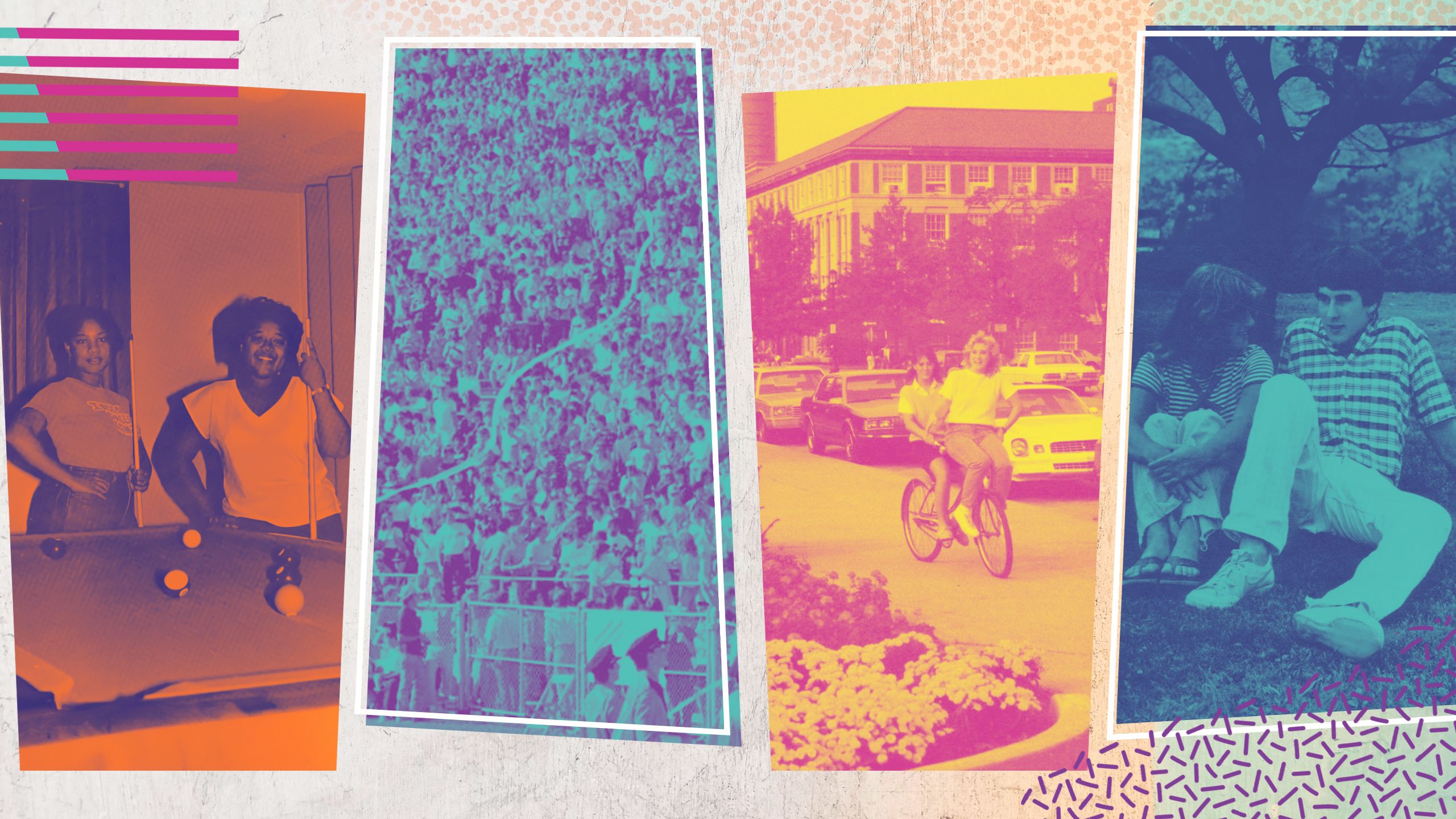
BREAKFAST CLUB
Named after the 1985 movie, Breakfast Club got its start on campus in the mid-’80s. Students woke up early (if they had gone to bed at all), wore pajamas or costumes, and visited campus bars such as T.A. Tom’s, Edo’s, and Pete’s.
Purdue students raised $10,000 in two months to support the Multiple Sclerosis Foundation (MSF) through the efforts of the Purdue Association Against Multiple Sclerosis (PAAMS). PAAMS was formed when MTV and MSF challenged college campuses to join the fight against MS.
Griffin One, an experimental energy-efficient house, was designed by Purdue professors in building construction and contracting; mechanical engineering; consumer and family sciences; and agriculture and landscaping. The 2,000-square-foot house, constructed in a subdivision north of campus, included features that helped cut heating and cooling costs: an antifiltration barrier, a sunspace to gather heat like a greenhouse, an air-to-air heat exchanger, and an air-lock entry. House plans were made available to the public for $40.
The Speech and Hearing Clinic celebrated its 50th year and was renamed the Max D. Steer Audiology and Speech-Language Center (today known as the M.D. Steer Speech, Language, and Hearing Clinics) to honor its founder.
Max Headroom, a faux-CGI TV celebrity and ’80s cult hero known for his stutter, led the Homecoming parade as the grand marshal. Headroom was the national spokesman of Coca-Cola at the time, and he was on a promotional tour with a scheduled stop at Purdue. Because the character was nothing more than a head on a screen, he appeared on four TVs perched atop a limousine that drove along the parade route. The tagline for his visit was “Catch the B-B-Boiler Wave.”
The Visitor Information Center opened on the ground floor of the newly renovated Northwestern Avenue Garage. President Beering was instrumental in establishing the center, which offered campus tours and served as a hub for community relations.
The “All-American” Marching Band celebrated its 100th anniversary and was presented with the Alumni Service Award by the Purdue Alumni Association.
Electrical engineering student Fred Giles (ECE’88, MS ECE’91, PhD ECE’96) was named the university’s first Presidential Merit Scholar.
Purdue Alumnus
Purdue Alumnus
Purdue Exponent
Purdue Exponent
Debris
Debris
Purdue University Archives and Special Collections
Purdue University Archives and Special Collections
Debris
Debris
National Archives
National Archives
Top: Greg Griffo/IndyStar. Middle and bottom: Debris
Top: Greg Griffo/IndyStar. Middle and bottom: Debris
Purdue’s Public Affairs Video Archives, set up to record C-SPAN programming, began 24-hour taping of the public-affairs network’s offerings.
The FWA 8 building, built as part of the Federal Works Administration project during World War II, was torn down. The pre-engineered building was brought to Purdue in the late 1940s along with others that housed lecture halls, classrooms, and labs for various departments.
Air Force One touched down at the Purdue Airport when President Ronald Reagan came to West Lafayette in April; he was the first American president to visit the university. More than 19,000 people gathered at the airport for his arrival. Traveling by motorcade, he toured Knoy Hall and the Michael Golden Engineering Laboratories and Shops. He ended the trip with an assembly in Mackey Arena, during which he was presented with a two-foot-tall flag-waving robot named ET (Engineering and Technology) Purdue, a Purdue-branded calculator, and a gold-plated Boilermaker Special ornament.
The Center for Paralysis Research was established in the School of Veterinary Medicine as an independent neurotrauma research center with an emphasis on spinal cord injury. In its first year, the center’s team successfully reversed a formerly permanent defect in adult guinea pigs and restored function in about 25% of the test animals.
Elliott Plaza, an area between Hovde Hall and Elliott Hall of Music that was once a driveway, was created thanks to a gift from the Class of 1936. Decorative brickwork, mature trees, benches, and ornamental lighting accented the space.
The “All-American” Marching Band joined in the nationwide commemoration of the bicentennial of the signing of the United States Constitution with a bell-ringing celebration on the steps of Hovde Hall. Across the country, bells were rung for 200 seconds at 4 p.m. on September 17 to honor the special day.
The Bob & Tom Show broadcast live from the West Main Lounge of the Purdue Memorial Union on October 15. Bob Kevoian and Tom Griswold, hosts of the show, were on the road for a college promotional tour. At each stop, a $950 cash scholarship was presented to a student, courtesy of Pepsi.
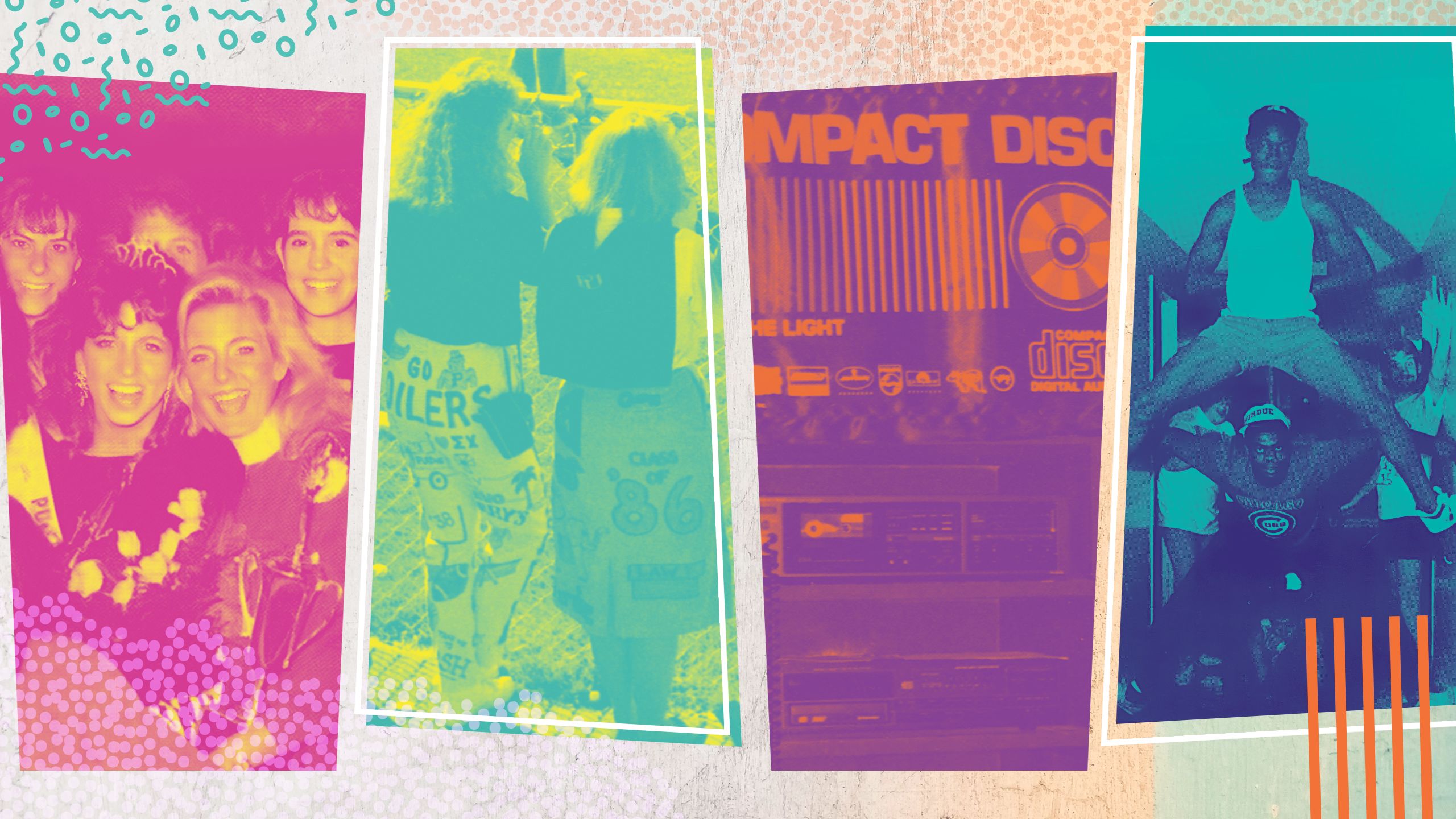
A SLICE ABOVE
Garcia’s. Pizza Keg. Godfather’s. Veno’s. Papa Del’s. Bianco’s. Rico’s. Bell’s Pizza House. Gone but not forgotten, these popular restaurants served up pies to hungry Purdue students in the 1980s. Many nutritionists touted the health benefits of pizza during that decade, even naming it the most nutritional fast food. We could get down with that.
The university celebrated its 100th year of granting honorary degrees, bestowing upon popcorn king Orville Redenbacher (A’1928, HDR A’88) a doctorate in agriculture during a spring commencement ceremony.
Purdue accepted a five-year grant from the National Institute of Allergy and Infectious Diseases to set up an AIDS research center.
The Materials and Electrical Engineering Building at the east end of Purdue Mall was dedicated during a three-day centennial celebration for the School of Electrical Engineering. The area between the new building and Hovde Hall—which had once been the main entrance to campus off Northwestern Avenue and included a drive and parking spaces—was closed off to make way for a pedestrian-friendly plaza and green space.
New construction projects were announced, although they wouldn’t be completed until the 1990s: a state-of-the-art indoor practice facility for football; the Bell Tower, funded by the Class of 1948; and the Class of 1950 Lecture Hall, which would replace the old Physics Building.
The School of Humanities, Social Sciences, and Education, known as HSSE, became the largest school at Purdue, celebrating 25 years as a school and 50 years as a program. Due to its swelling enrollment, the school could not accept applications from out-of-state students for the fall semester.
The Department of Restaurant, Hotel, and Institution Management (now the School of Hospitality and Tourism Management) opened a European-style sidewalk café between Stone and University halls. The restaurant was part of the student training offered by the department’s Stone Hall cafeteria and included a genuine hot dog cart complete with condiments and sauerkraut.
Purdue launched its Distinguished Lecture Series to celebrate creative genius and provide a forum for the discussion of great ideas. The first three speakers were the paleoanthropologist Richard Leakey and the actors Alan Arkin and Helen Hayes.
Purdue mobilized its most extensive cooperative education effort during the drought of 1988, the worst drought since the Dust Bowl and one of the costliest U.S. natural disasters of the 20th century. The College of Agriculture and Purdue Extension created a drought-information system—including a toll-free hotline—that utilized hundreds of staff and faculty to provide information to farmers, consumers, businesses, and media worldwide.
Purdue University Archives and Special Collections
Purdue University Archives and Special Collections
Purdue Engineer
Purdue Engineer
Debris
Debris
Artist rendering: Purdue Alumnus
Artist rendering: Purdue Alumnus
Purdue Alumnus
Purdue Alumnus
Purdue Alumnus
Purdue Alumnus
Debris
Debris
Debris
Debris
Debris
Debris
Stacy Clardie/Purdue Engineering
Stacy Clardie/Purdue Engineering
Enrollment reached more than 35,000.
Purdue announced that bicycles would be allowed on sidewalks—previously, bikes were prohibited in many parts of campus, including, confusingly, areas that housed bike racks.
The Department of English launched the literary journal Sycamore Review, named after one of Indiana’s largest deciduous trees. Capital for the journal was provided by an endowment and matching university funds. The journal, which published its final issue in 2023, contained works of poetry, short stories, essays, nonfiction, interviews, book reviews, and art by both new and established writers and artists.
For the first time in school history, students had to pay for season football tickets. They protested via letters to the Exponent and by boycotting games at Ross-Ade Stadium. Purdue was the ninth school in the Big Ten to institute such a policy.
Students chose five finalists to compete for Purdue’s first Homecoming King, with Walt Quinn (M’91) winning the crown. The king contest was sponsored by Boilermaker Steam, a student club that supported the athletic teams.
The Exponent moved into the newly constructed Exponent Journalism Center on Northwestern Avenue; staff formerly worked in the Union subbasement.
HSSE separated into two schools: Liberal Arts and Education.
The Class of 1939 Water Sculpture was installed in front of Hovde Hall on Purdue Mall. A gift from the Class of 1939 to commemorate its 50th anniversary, the fountain was designed by Indiana sculptor Robert Youngman. It was originally built with an open jet that shot 588 gallons of water per minute straight up into the air, but a stainless steel cylinder was added in 2001 after several people were injured while running through the fountain.
A GLIMPSE OF OLD INDIANA IMPRESSIONS
From the dark sky, the sun of a new day
is about to reveal its beauty.
Yet this day, unlike others, shall bring a
softer light marking the dawn of a new season.
Colors fill the land reflecting memories
of the longer days of summer.
Clouds fuller and darker warn of the approach
of yet another season.
Nestled warmly in its blanket of newly fallen
snow, the earth waits patiently for new paths
and new memories to be made.
This season is made for those who remember
and those who hope.
—Elizabeth (Kurtz) Hudelson (ME’81)
This poem, written by student and Debris staff member Betsy Kurtz, was published in the 1980 yearbook.
A GLIMPSE OF OLD INDIANA IMPRESSIONS
From the dark sky, the sun of a new day is about to reveal its beauty.
Yet this day, unlike others, shall bring a softer light marking the dawn of a new season.
Colors fill the land reflecting memories of the longer days of summer.
Clouds fuller and darker warn of the approach of yet another season.
Nestled warmly in its blanket of newly fallen snow, the earth waits patiently for new paths and new memories to be made.
This season is made for those who remember and those who hope.
—Elizabeth (Kurtz) Hudelson (ME’81)
Written by student and Debris staff member Betsy Kurtz, this poem was published in the 1980 yearbook.


